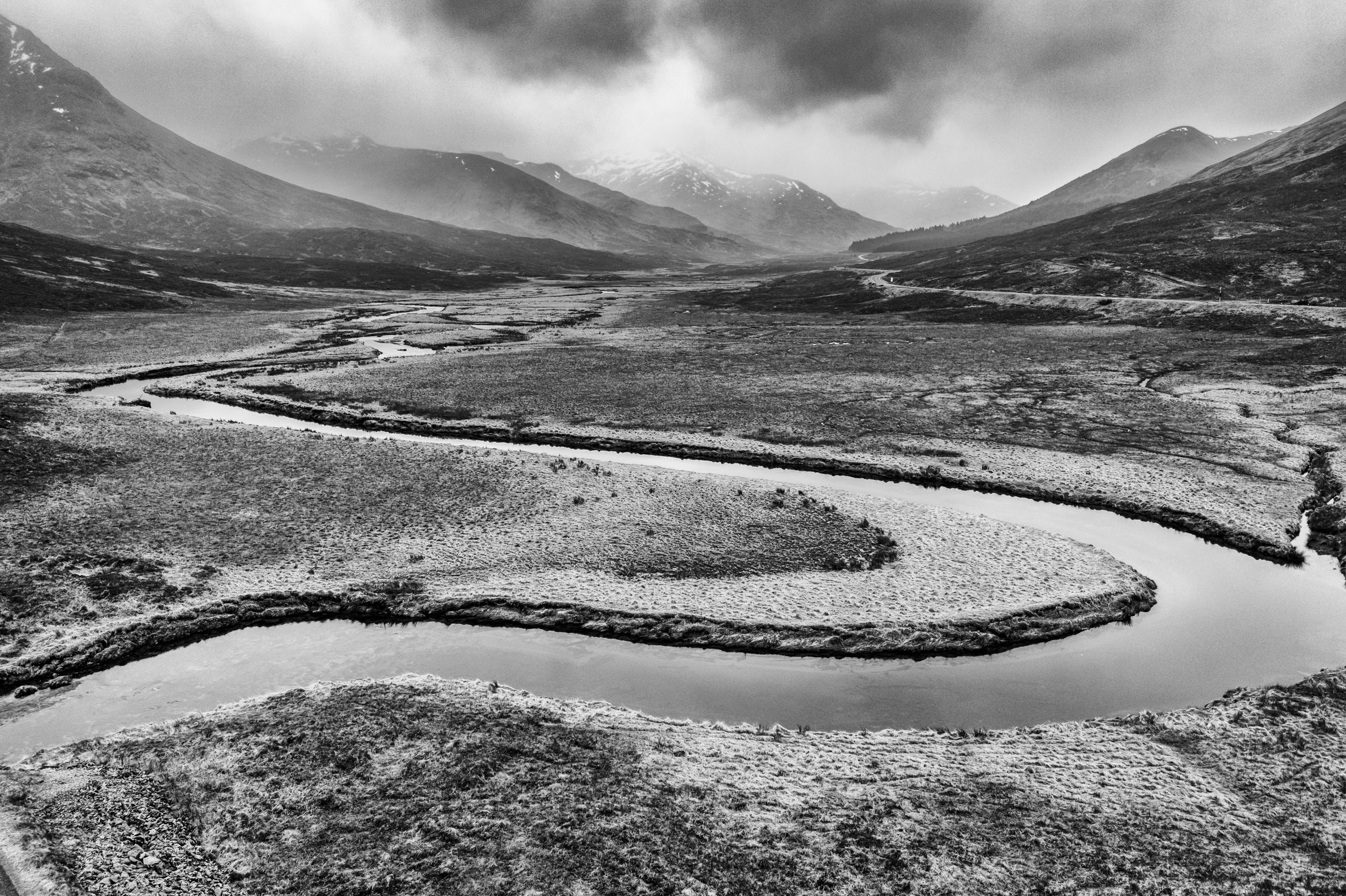
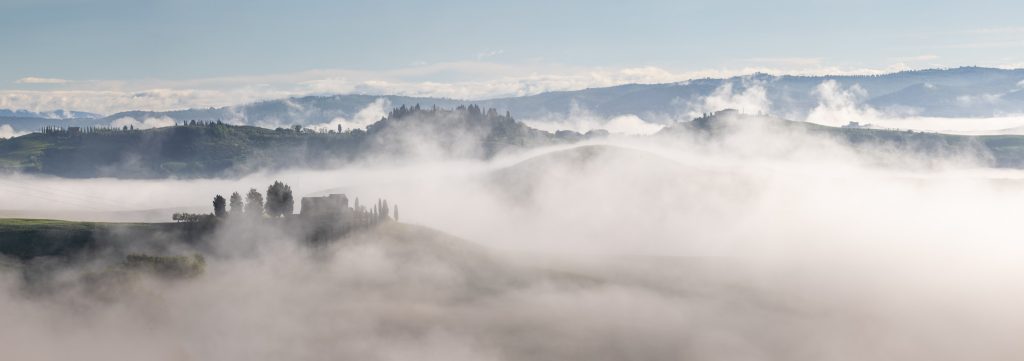
Welcome to the August 2023 newsletter.
It’s been a long time since I sent out a newsletter. It’s not been through a lack of travelling or having nothing to say. On the contrary, there’s been a complete lack of time due to a crazy schedule, which isn’t slowing down anytime soon.
During the several months of 2023, I’ve been to Vietnam twice, Scotland, India, Nepal and Tuscany. A fair few miles have been travelled and numerous stories to boot. As always, there are tales to tell and imagery to go along with them.
So let’s get up to speed with trip reports in date order as well as future photography workshop dates for those of you who are interested.

Each year in January, I take those who are willing to embrace the fickle Scottish weather on a photography tour of Glencoe and its surroundings in the north-west. Fickle, as in the weather, will essentially throw anything and everything at you.
The panorama above accurately highlights the weather that we faced over the 5 days and 4 nights we were there. Wet and overcast. But then, if you add in the glorious mountain scenery that’s to be found, it provides for some incredibly atmospheric imagery to train your lens on.
The photography tour is centred in the Glencoe area, but I also tend to keep an eye on the weather elsewhere, just in case participants need to be taken somewhere else. The last thing I want is a bunch of photographers stuck in a hotel gazing out of the window.
Over the course of the 5 days, we had a small break in the weather which was the Friday. Glorious skies opened up above us, and we had a break from covering our cameras from the downpours.
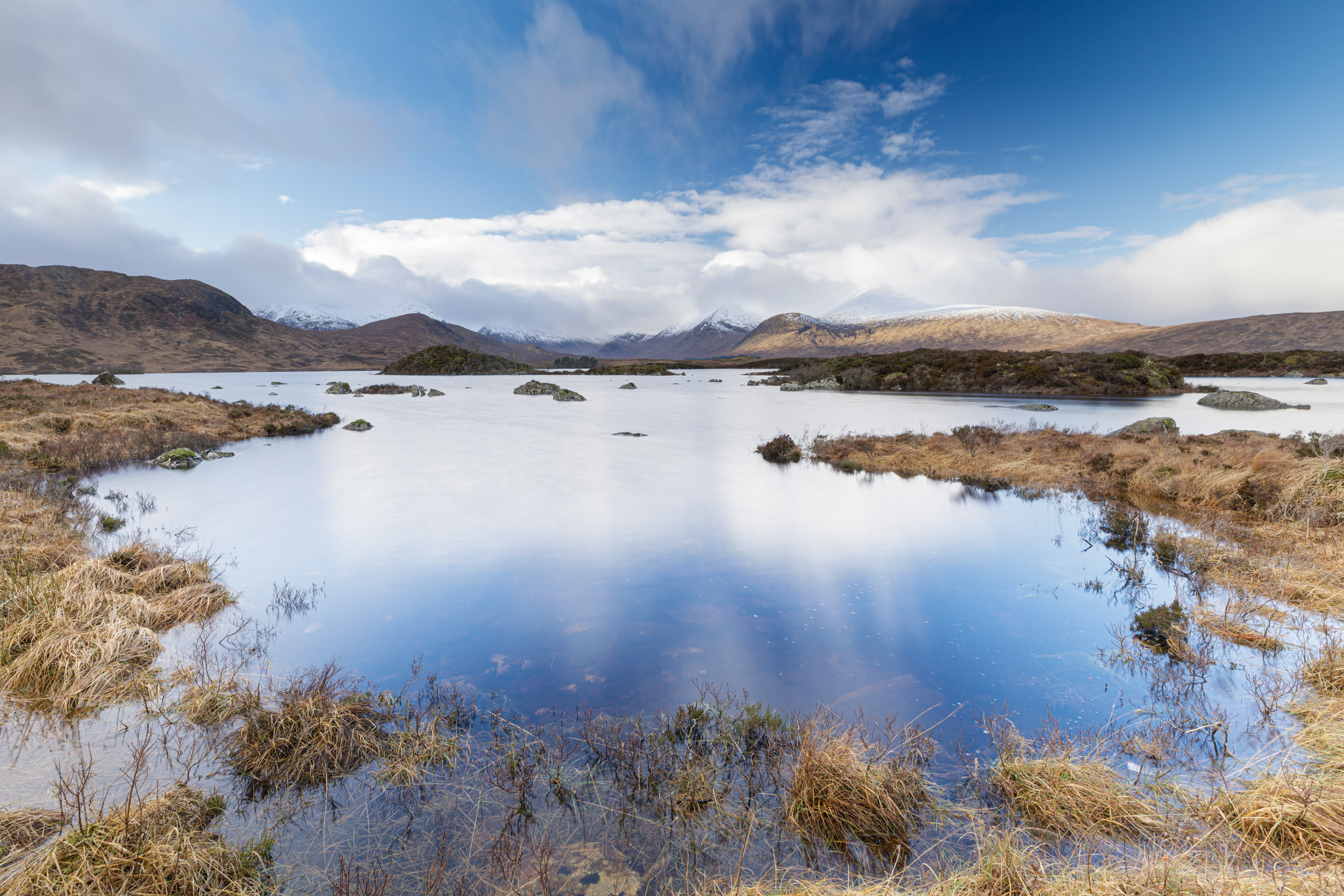
The strange thing is, though, at times you need that cloud cover and threatening weather to set off the surrounding landscape. I always say to people that although places such as Rannoch Moor can be bleak that within it lies its beauty.
Most people would look at the weather we experienced during the photography tour and turn their noses up. To their credit, each of the five participants took the bull by the horns and came back with some great imagery. So never be afraid of the Scottish downpours. You may just come back with a stunning image.
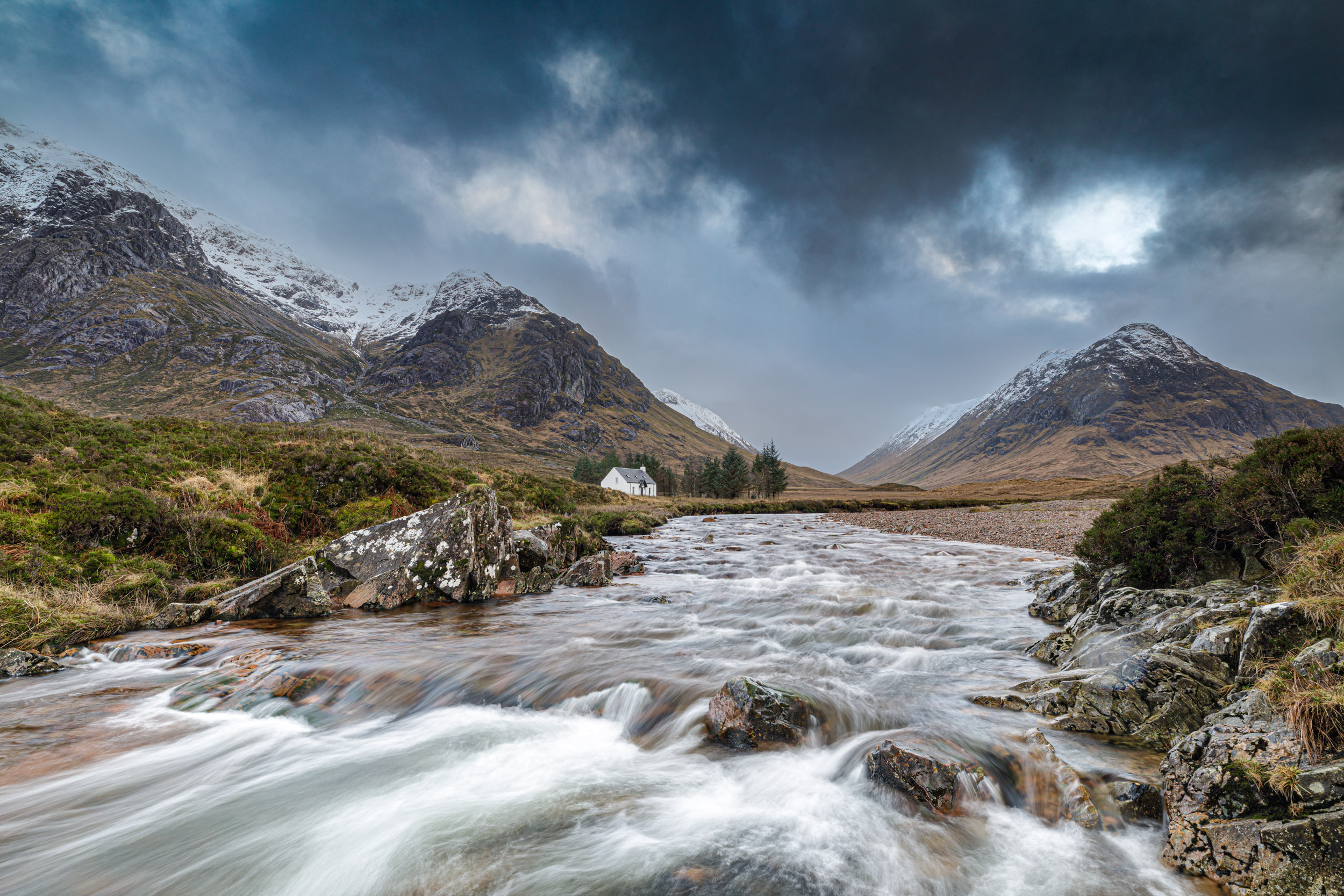
After finishing up with the photography tour in Glencoe, I headed back down south. A number of camera clubs had booked me to give presentations on a variety of subjects from my travels. But then the end of January saw me head back up to Scotland to run a photography tour on the Isle of Skye.
The photo tour had a sole participant, as I had forgotten to ask Google to index the tour page, thus it only got in the search listings very late in the day. But if at all possible, then I don’t let this stop it from running, as someone has paid me, thus they deserve to get their purchase.
After meeting my client at Glasgow Airport, we headed north on the drive to Skye. Stopping overnight in Fort William, I introduced her to Glencoe as a treat, as I felt that simply driving by would have been an injustice and especially as she had come all the way from Australia!
Just before the Glencoe Pass is the glorious Buachaille Etive Mor, with Lagangarbh Cottage sitting at the foot of it. It’s the same cottage that you see in the trip report above, but this time it’s shot from the roadside.
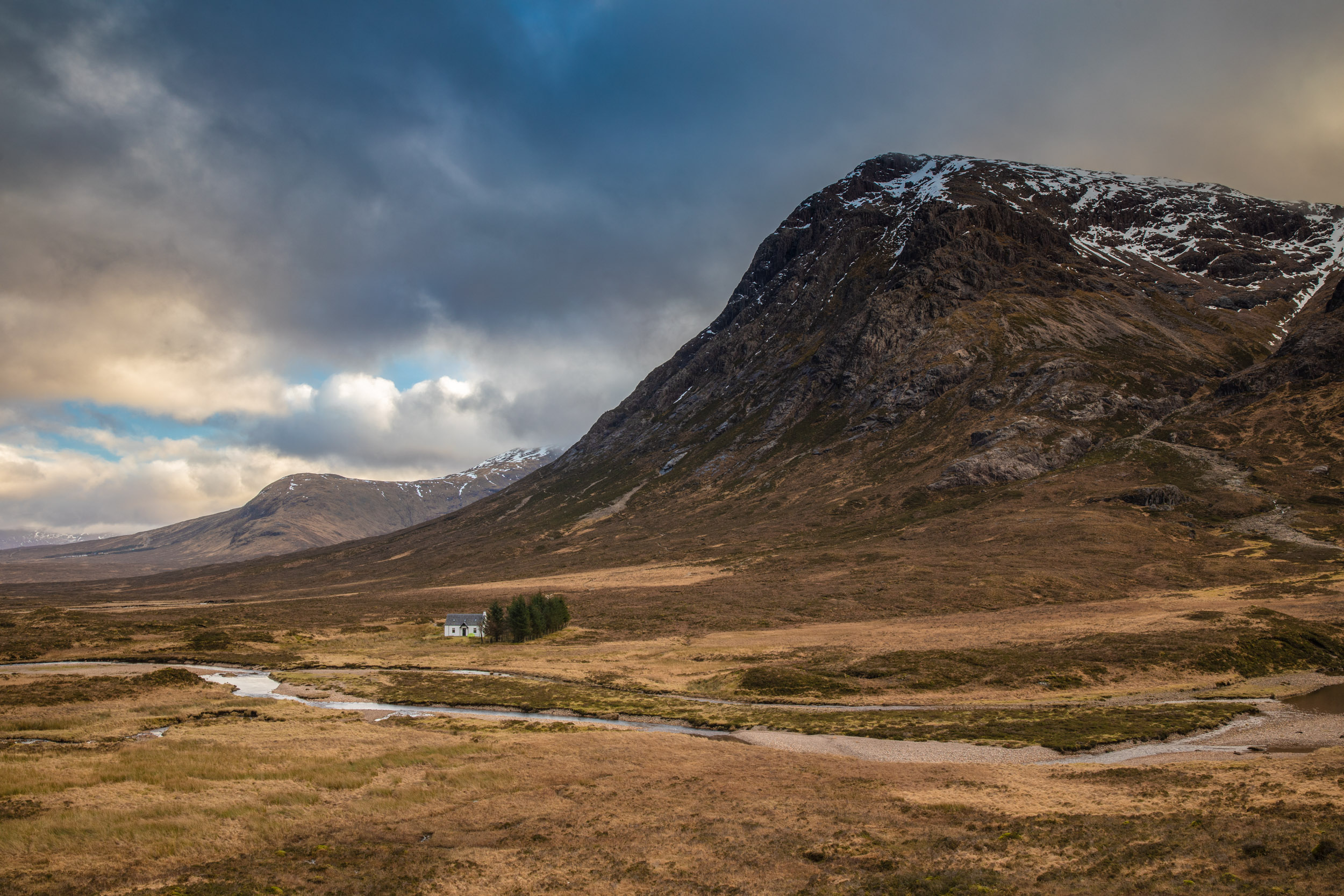
This small but perfectly formed bolthole is available to sleep in overnight as it forms part of the Scottish Mountaineering Club’s properties. But of course, for photographers, it adds a perfect sense of scale to the aforementioned mountain.
After a quick jaunt down to Castle Stalker, we got some rest before heading north to Skye for a 5-night tour of the island.
The Isle of Skye has become an absolute mecca for photographers and photography tours. However, in January and early February, you’ll find that the island is quiet. The Scottish weather is what likely puts people off, but as mentioned in the Glencoe report above, it absolutely shouldn’t do.
The first evening was spent on the beach at Elgol. A stupendous location that was made famous by Joe Cornish with a shot that he did with a huge boulder in the foreground and the mountains in the back.
But as the wind was pounding the coastline and the rocks were on the slippery side, we decided to stay safe and shoot from the beach. This did not disadvantage us in any way, as there was a tiny crack in the sky with a little of the pink of sunset hitting the clouds.
Here you’ll see the waves crashing in, so it was a matter of timing to get the curve and the right waves breaking on the beach whilst pinning the tripod down.
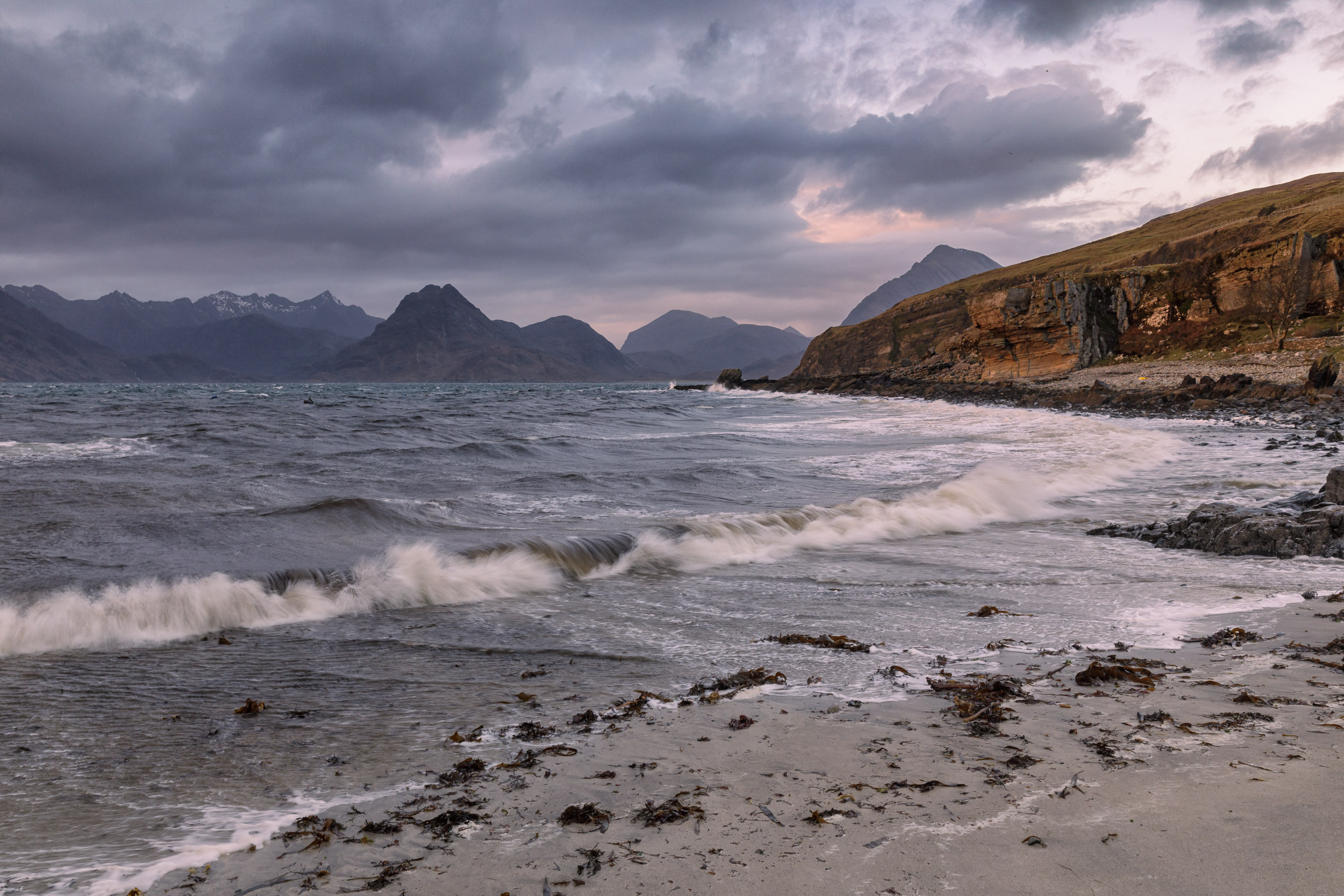
Day 2 started with sunrise, looking down the Trotternish Ridge. It’s a location I’ve been to a number of times, and it never fails to deliver. A beautiful sunrise graced the landscape before us before we headed back to breakfast and then set about planning the day.
Somewhere that had been on my list of places to get to was the old marble mines. I had known about an abandoned building there for a number of years, but had never had an opportunity to go up and find it. Thankfully, my client revelled in photographing old and abandoned buildings, which helped set the scene for a lot of what we did for our time on the island.
As the sun stays relatively low during the winter up in the Highlands of Scotland, it meant that if conditions were right, then we could shoot pretty much all day, providing, of course, the heavens let us do so.
The marble mine is a short walk from an old cemetery, and so we took the muddy path up and found our prize. A prize that, with a little patience, saw the clouds break a little and the sun peek through long enough to give shadows across the landscape.
To me, shadows are extremely important when it comes to the creation of my images. They add that all-important dimension to the final product and give the viewer a sense that they could almost run their hands across the photograph and touch the elements within.
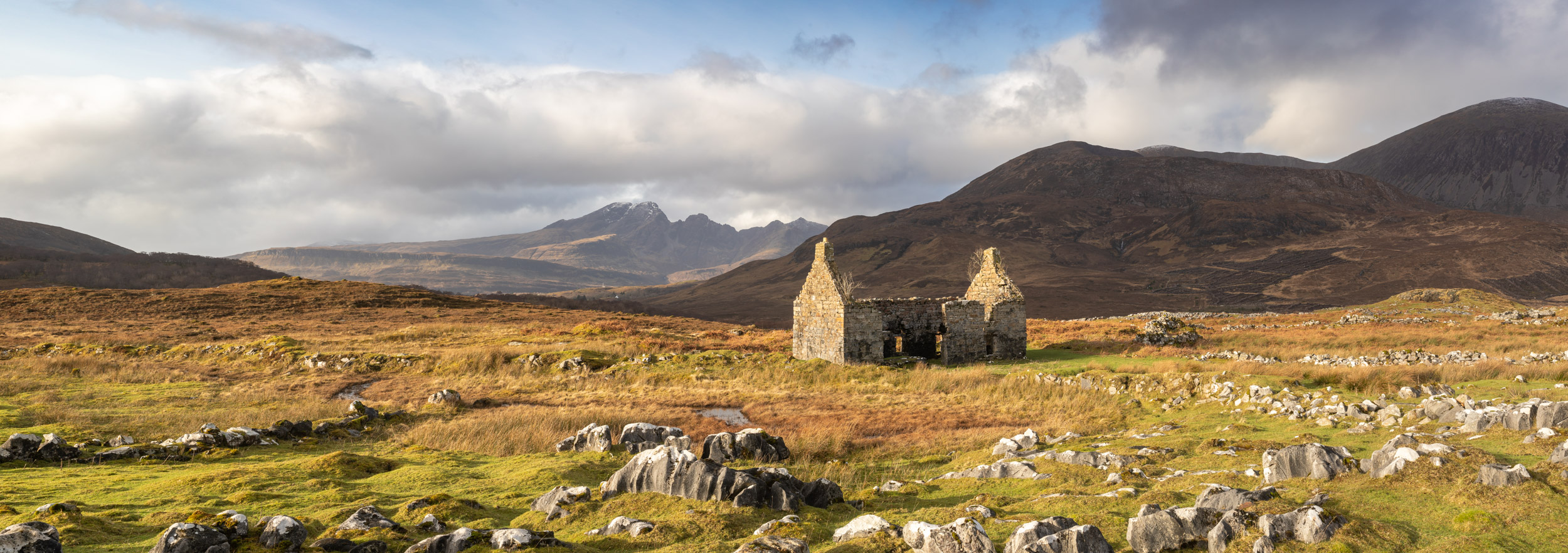
The third day on the Isle of Skye we slept in. The elements got the better of us so we decided a lie in would help us recharge the body batteries, gather our thoughts and see what we could gain back in terms of locations.
Having had a long discussion about abandoned buildings the previous day it had set in motion another idea for me. An abandoned house that I had seen “somewhere” on the island. Where? I had no idea as I’d only ever seen one image from this place which is extraordinary given how well photographed the Isle of Skye actually is.
The previous evening I had spent a good couple of hours tracking the building down and eventually found it through an estate agent’s website of all places. I had to sit and compare the images with the sole image I had seen elsewhere to verify that it was the same place.
The one thing that continually struck me about this building was the roof. It had collapsed in, but in an artistic way, if I can say that.
As it had been left to rack and ruin, the aforementioned roof had collapsed as the owner was supposed to renovate the place, but had let it go to the elements. Those elements had seen the roof create an almost fan-like structure, which looked glorious. Add to that a decent break in the weather, and we had our image.
When you look at the photograph, it looks nice and serene. The clouds were broken up, and the sun was shining across the landscape. But it was, in fact, gale-force winds hitting us, and we were lucky to get anything resembling a sharp image.

As February 1st chimed in, we got up early and headed back up to the Trotternish Ridge, hoping for another glorious sunrise. We didn’t get much in the way of sun, but certainly got enough wind and quick showers.
A skill that I underline with anyone that comes out with me is to keep a constant eye on the weather around you. Eyeballing what’s going on in the heavens above to ensure you don’t get caught out by an unexpected downpour, which in turn results in a soaking.
As you can see, there was a weather front headed towards us, so we needed to be mindful of what it was bringing and ensure our own safety.
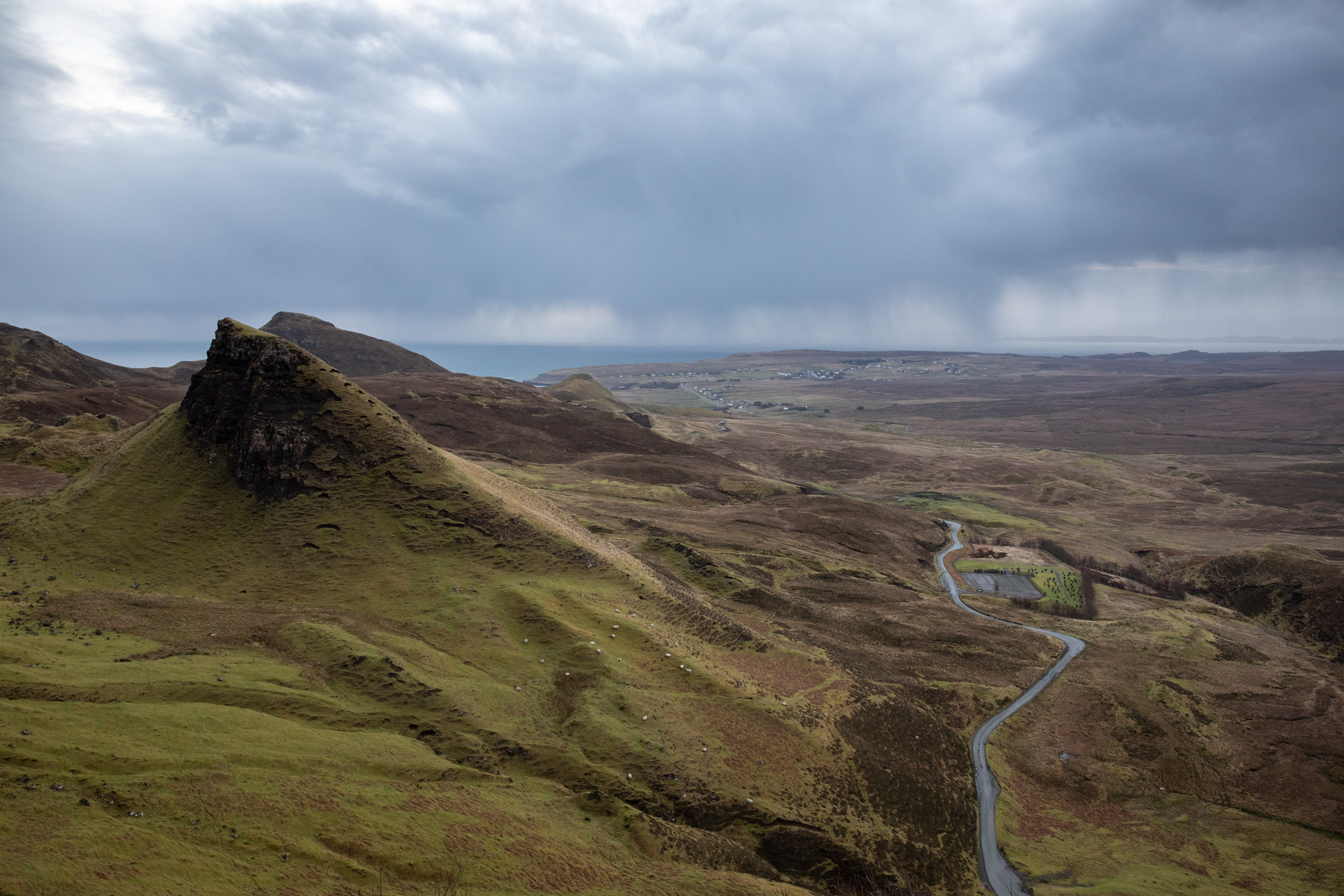
Our last day on the island saw us decamp to Glen Shiel, then head over to the famous lighthouse at Neist Point.
Glen Shiel is one of those places that just doesn’t get enough love. It is a breathtaking, long, mountainous valley that sits just before the Kyle of Lochalsh. As people seem to be fixated on getting to the Isle of Skye, they tend to ignore the location, which is daft given the incredible opportunities it holds.
Glen Shiel is one of those places I could happily spend a week in and go nowhere else. There really is a huge amount to be done here that I am itching to get back again.
There are a number of pull-offs along the main road where you can get some stunning imagery. For the shot below, I used my DJI Mavic Pro 2 in order to gain a little height so as to accentuate the leading lines in the river meandering its way through the glen.

After the Scottish weather forced us undercover, we headed up to Neist Point, and surprisingly, we had the place to ourselves. Surprisingly? Well, I guess not, given the blustery conditions, but normally at sunset you should expect to see a long line of photographers dotted along the high cliffs overlooking the sea towards the Outer Hebrides.
And so it brings a cautionary tale. As we were nearing the car, a young lady was walking towards us. She asked for the best viewpoint of the lighthouse. Nothing untoward there, you might think. But it was her footwear that astounded us.
The ground on the clifftops was soaking wet, and in our hefty walking boots, it wasn’t easy navigating our way across. But the young lady only had on some flat-bottomed city shoes.
It cannot be said often enough. If you’re going to go out in the countryside or along the clifftops, then take appropriate footwear. The last thing search and rescue need is to be scraping you off the rocks, as you couldn’t be bothered to go out with better shoes on.
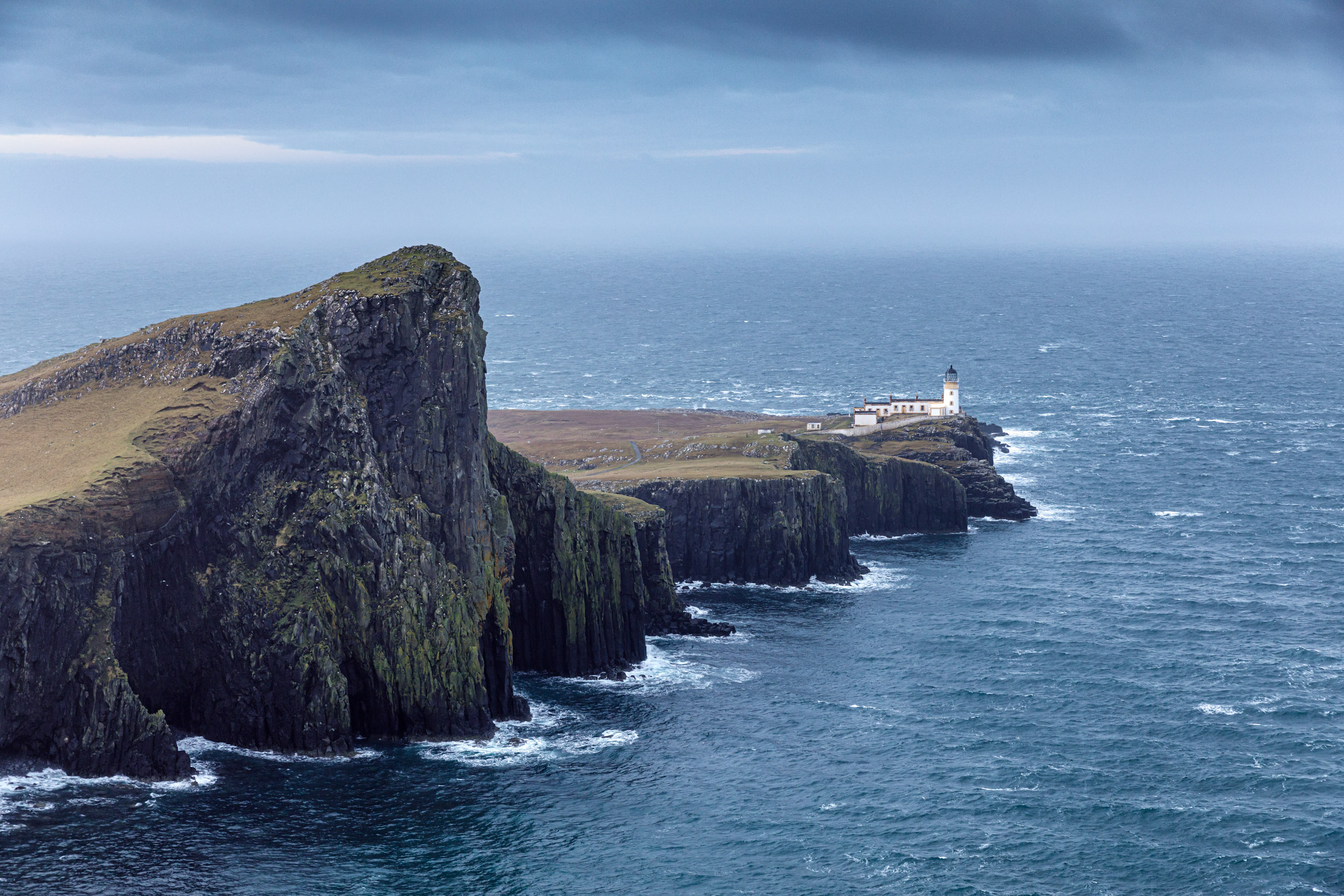
After the windswept landscapes of north-west Scotland, it was time to head to Vietnam. To discover some new places so as to further build my knowledge of this beautiful country.
Vietnam is a place that I have simply fallen in love with. I love arriving in the country as it feels like I’m back home. The people are amazing here, and for a photographer, there is so much to do that you could just never cover it all during a lifetime.
But this is a trip that was filled with disaster. A disaster that saw my gear nearly ruined to the point that my career would have been over. Yes, it was THAT bad!!!
The first five days of my trip, I had been out discovering new places around the outskirts of Hanoi. I returned to the incense village as I had a particular image in mind that I wanted to capture.
North of Hanoi, there is a village that is famous for producing rice paper. My guide and I wandered around getting a feel for what goes on in this little-visited corner north of the capital.
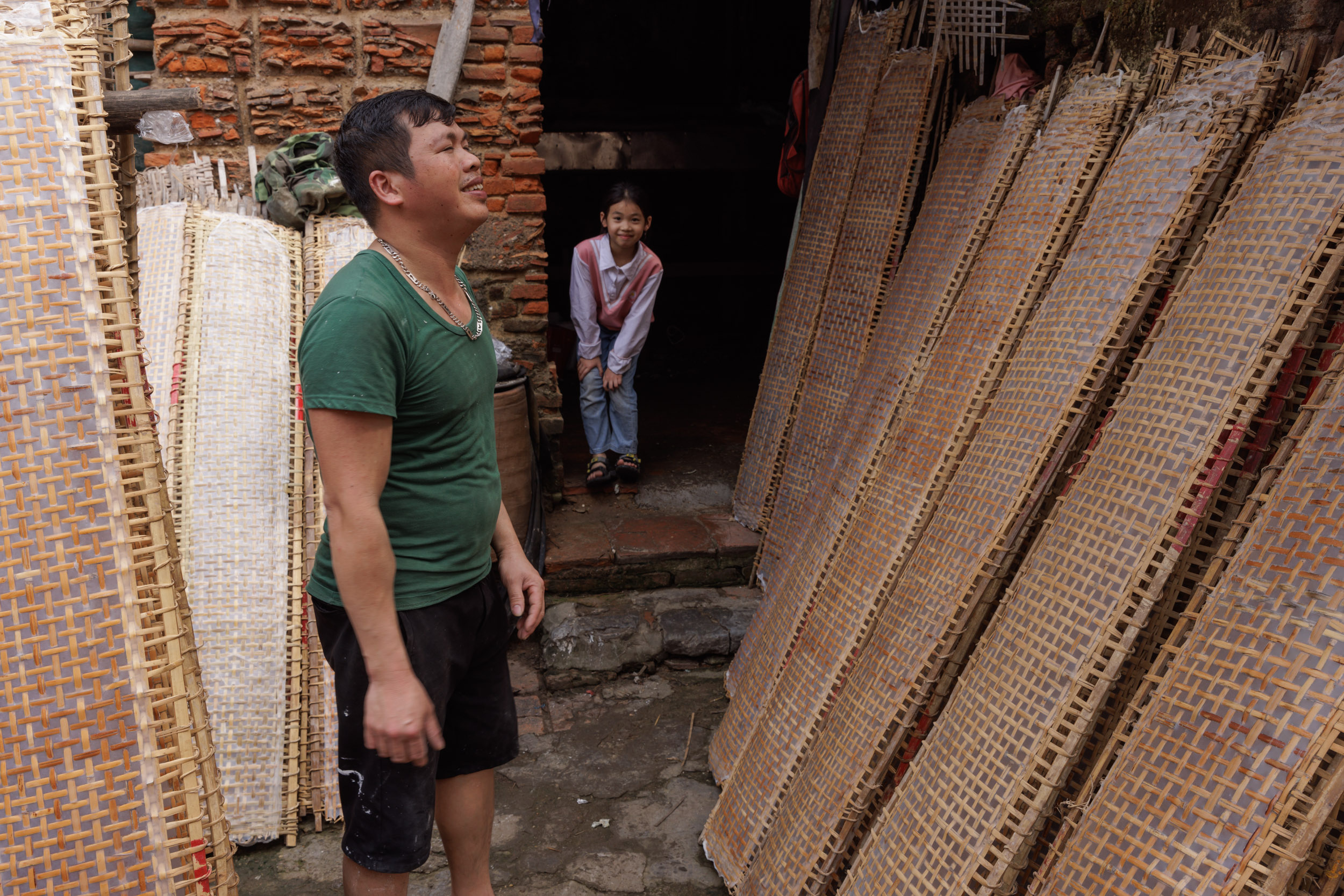
After a few days discovering some places around Hanoi, we flew down to Dalat, which is in the Central Highlands region of Vietnam.
In and around the city, I wanted to photograph a lake with a traditional fisherman as well as the centre of the city. I had seen images from the market here, and it looked interesting, so that was added to the hit list of places to do.
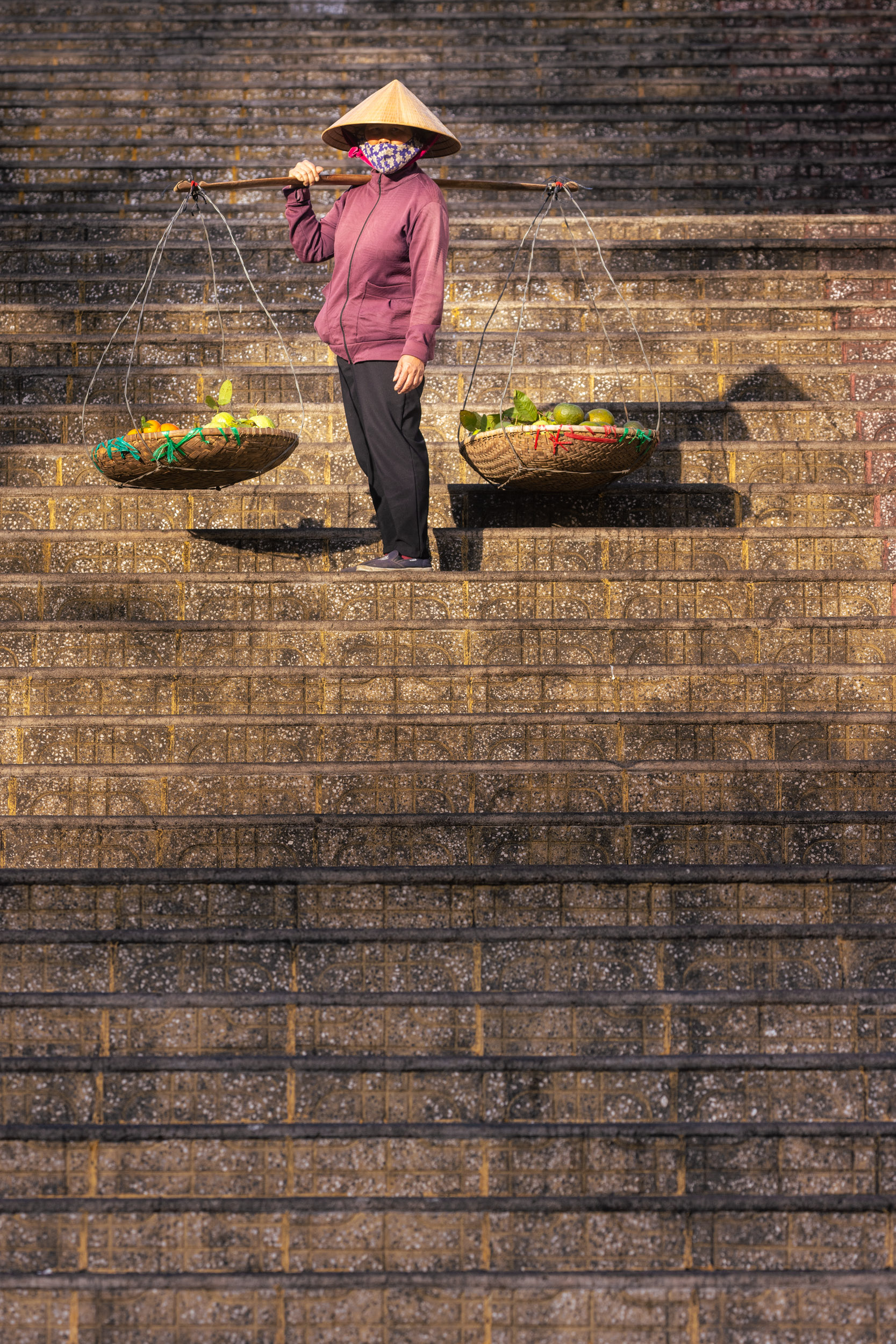
So everything was going well, then disaster struck.
The end of the trip was scheduled for the coastal part around Nha Trang. Here, there is a beautiful long beach by the city, as well as a few other things that can be found.
On the morning of 17 February, we set about trying to photograph the coastline by the city. I stood watching the sea to make sure all was fine. The waves slowly lapped over the rocks by the seafront, and I eyed up what I wanted to do.
My camera bag was set down, and I set up my tripod with my tilt-shift lens on it. My shot was composed, then BANG!!!!!! A nearly 2-metre-high wave smashed me and my camera. My camera bag was flooded with seawater, and everything was soaked with saltwater.
Now, if you do a search for what you should do if your camera gets salt water on it, the advice is very simple. Go to the nearest funeral director and ask them when they can bury your camera. It’s that simple. It’s likely dead and not in any way, shape, or form likely to come back.
Do NOT turn your camera on. Whatever you do. DO NOT turn it on. This will short it out and definitely see it condemned. Get it to a repair shop ASAP, where they will likely do what seems counter-productive. It will be washed in fresh water, which in turn will remove the salt from the electronics.
You can see from the image that my gear is in bits. And I too was in bits. I was wondering if my career was finished as insurance will take a dim view of my misadventure by the coastline.
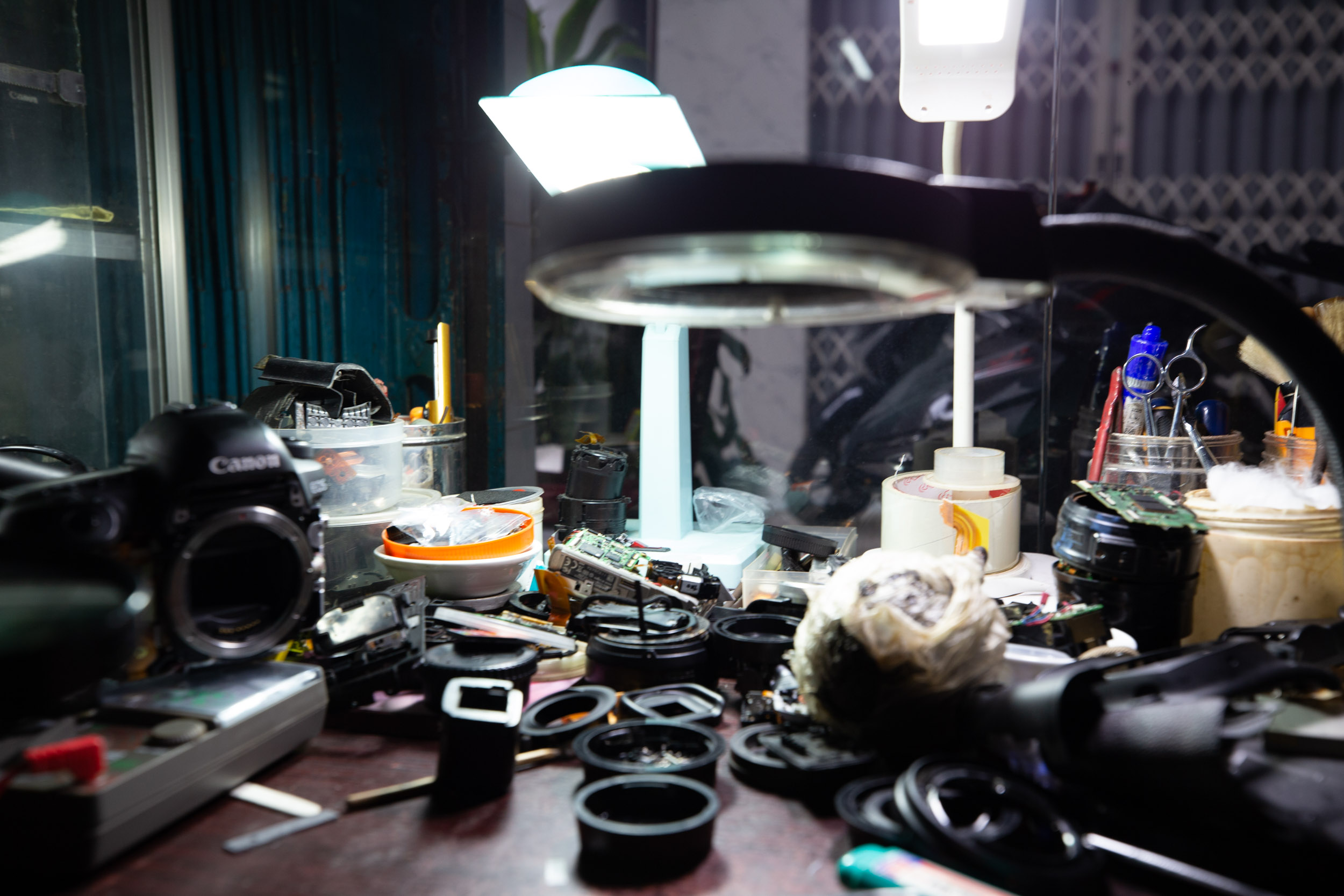
In the end, the bill for this cautionary tale was in the region of around 5000€ to get everything sorted out. Ouch! And ouch again! Not exactly what I needed, and especially so as I had a lot of work to be doing in the coming months in the form of photo tours and commissioned work.
The actual end of my trip in Vietnam ended in early March. In the central city of Hoi An, I met a number of new people who helped me further enhance my future photography tours to the area.
The first new character was Bui Quy Phong of the Timing Masks. He is a master mask painter, and his workshop is to be found in the backstreets of the city. Here you can spend a morning painting masks and then take your new work of art home with you once it’s dry.
What was special, too, was that during my flight home, he had been featured in the in-flight magazine for Vietnam Airlines, so it was nice to be reading about someone whom I had just met.
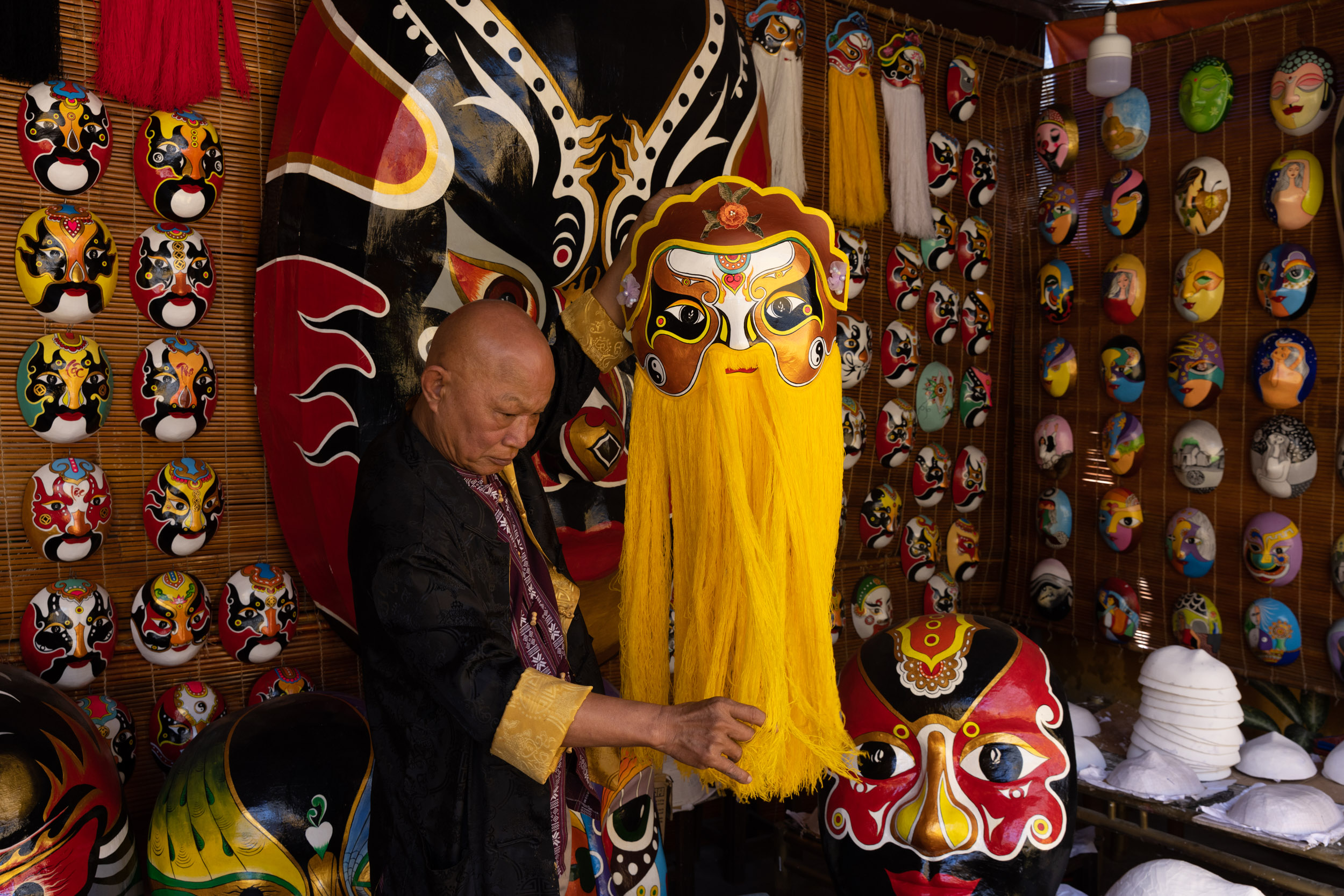
The other new character was Mrs Song. A 70-something lady whose face is probably the most well-known in Vietnam.
A few years ago, she had been photographed by a photographer from France in an image entitled “Hidden Smile.” So knowing that she lived in the area, I asked my friend in the tourism office if she knew how to get hold of her. To my delight, she had her son’s phone number, and so an afternoon was spent photographing this beautiful lady.
The thing is, like landscape photography, it would be very easy to recreate what has gone before. But personally, I’d rather find a new angle on a subject and see if things can be done in my own style and way.
Sat in her front room, the afternoon light came pouring in from the window. Softly illuminating her face, a beautiful Rembrandt shadow was under her left eye, which was what I was after.
As a travel photographer, you have to be aware of a number of domains within photography and portraiture is one that I love to do, given the right opportunities. And this was an opportunity not to be missed.
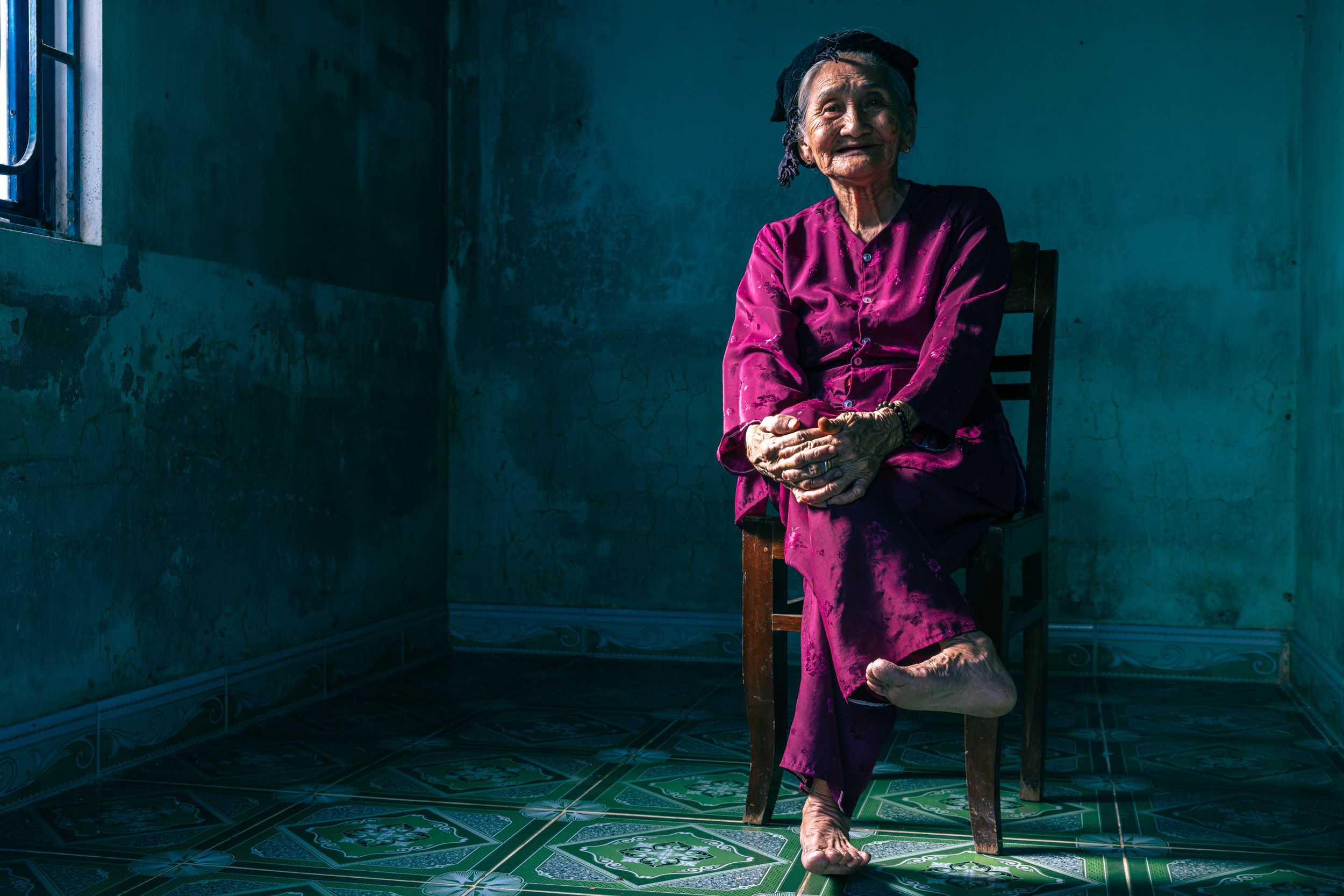
Now to a subject and trip report that I have erred on the side of telling. Erred because I wasn’t sure if I should publicly recount this or not but I feel that after what happened then I have to.
Back in January I had an enquiry about my Nepal trip. At this time it’s the only one I had but it didn’t surprise me given the hardships which need to be endured in order to successfully pull it off. And certainly given my trip there last year and getting altitude sickness I knew all too well what can happen if you are not prepared.
For the trip to run, it ideally needs two participants. The costs involved with a sole participant make it unviable. This was explained, and both the person who enquired and I went on the hunt for a secondary person.
Also at this time, I was asked at a camera club if the tour was going ahead. A guy came up to me and said he desperately wanted to go but that his other half had to be consulted first. Certainly not unusual given the costs involved.
But it was the first enquirer who came up trumps and found a second person to participate in the tour. The second person wasn’t a photographer, but they wanted to go and see this magical land.
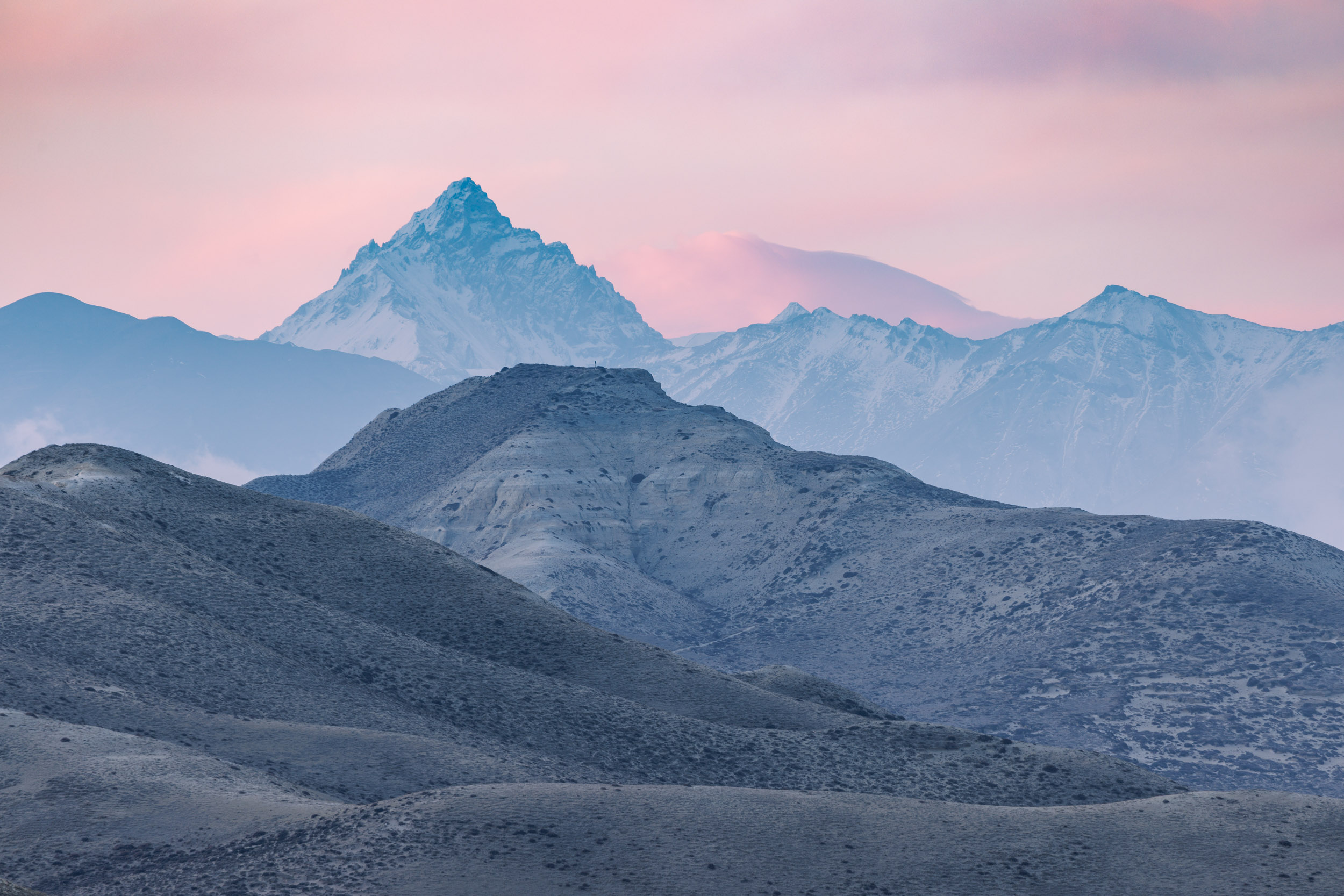
So, from here, information was relayed, and once the full balance had been paid, the tour notes were sent out detailing what they needed to know in order to have a smooth trip.
Both my website and the tour notes state that you need to be fully aware of where you are headed. It is in the wilds of Upper Mustang, and accommodation up there is basic. That you should in no way expect four-star hotels, etc, as they just aren’t available. You need to be fully aware of the climate that you are likely to experience, sub-zero temperatures, so even if it’s a blazing 28°c in Kathmandu, you’re likely to be below 0°c in Upper Mustang. And of course, there is the issue of being up at around 4000m in altitude, and you need to seek medical advice and medication from your doctor in the form of Diamox.
So you have been warned!
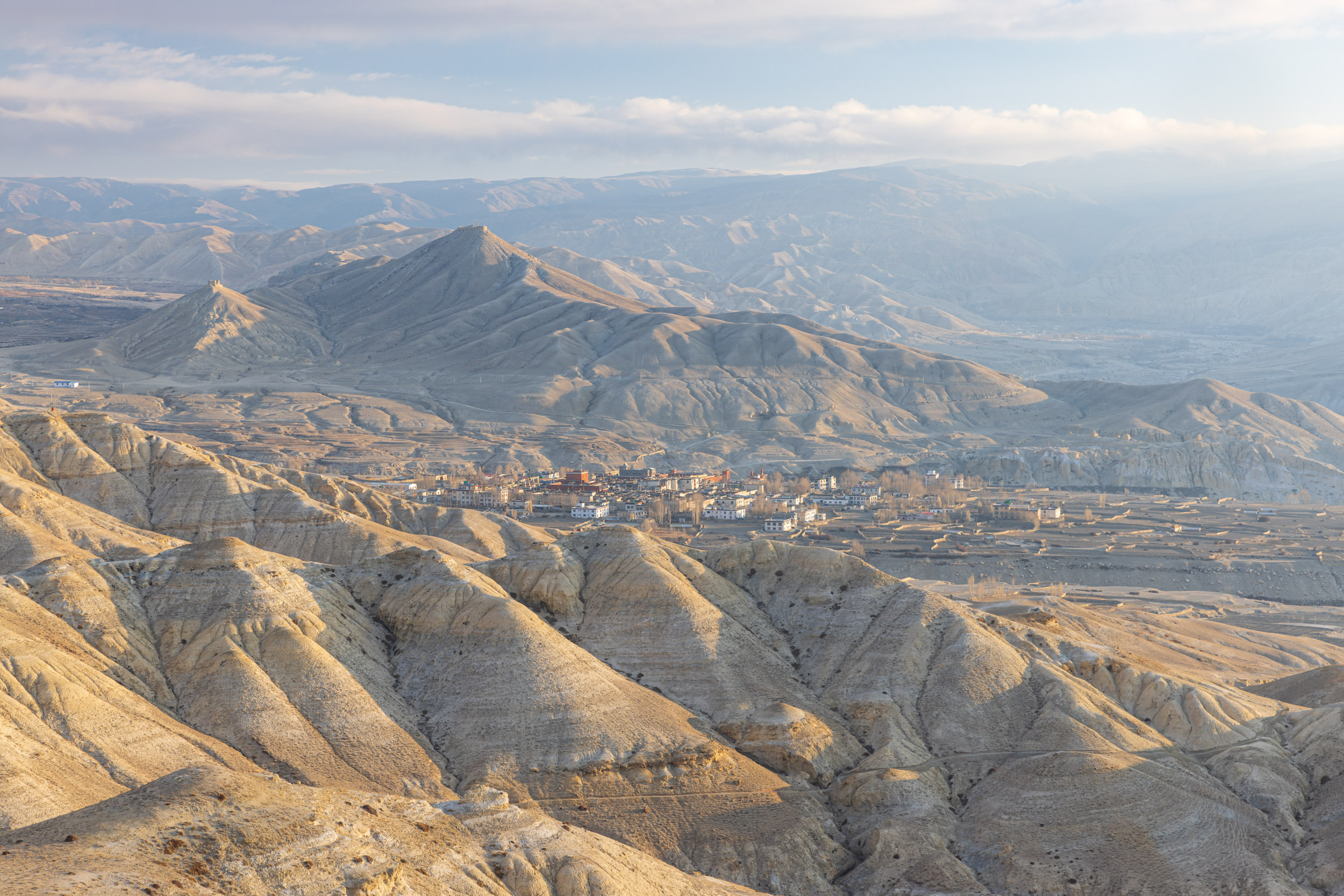
In addition to all of the above, it is always advised that you simply do not point your camera at someone and expect a nice smile. People in Upper Mustang have been given an extremely rough deal, and even I was told by a local, been mocked as backwards and whatever else by an outsider. So, please do exercise caution and ask before taking any photographs.
What followed throughout the two and a half week trip was a constant list of wholly unjustified complaints. No matter what I did, it was wrong. No matter what I said, I was wrong.
Let’s also add to this that the photographer turned to me and said that my work just did not inspire them in any way, shape or form. That they don’t like the way I work.
Folks, if you are going to go out with me or any other photography tour leader, then you must feel inspired by our work. I have since found out through my guide that the person involved has been messaging, asking for non-stop information on where we went and what we did.
It just isn’t on to use someone like me who has spent countless hours of research as well as money doing a reconnaissance trip to feather your own nest. Go with someone whom you respect, and if you have issues, then talk them through. And absolutely, if you find yourself interested in a trip that takes place in a remote area, then you MUST talk to the tour leader before any booking is made.
Two comments were made to me that underlined things. The first was that the photographer hadn’t read the trip notes. If this is the case, then they would have seen just what it was they were in for in terms of experience.
The second was at the end, I said to both clients that I hoped they had enjoyed the trip and that they had got what they came for. The photographer turned to me and said, “Well, you know you haven’t done a good job!” Which left me speechless given the amount of organisation that was involved and also that I had arranged an excursion from Delhi to Agra to see the Taj Mahal, finding the guide, driver and hotel accommodation. The other person just looked at me, and they too were speechless.
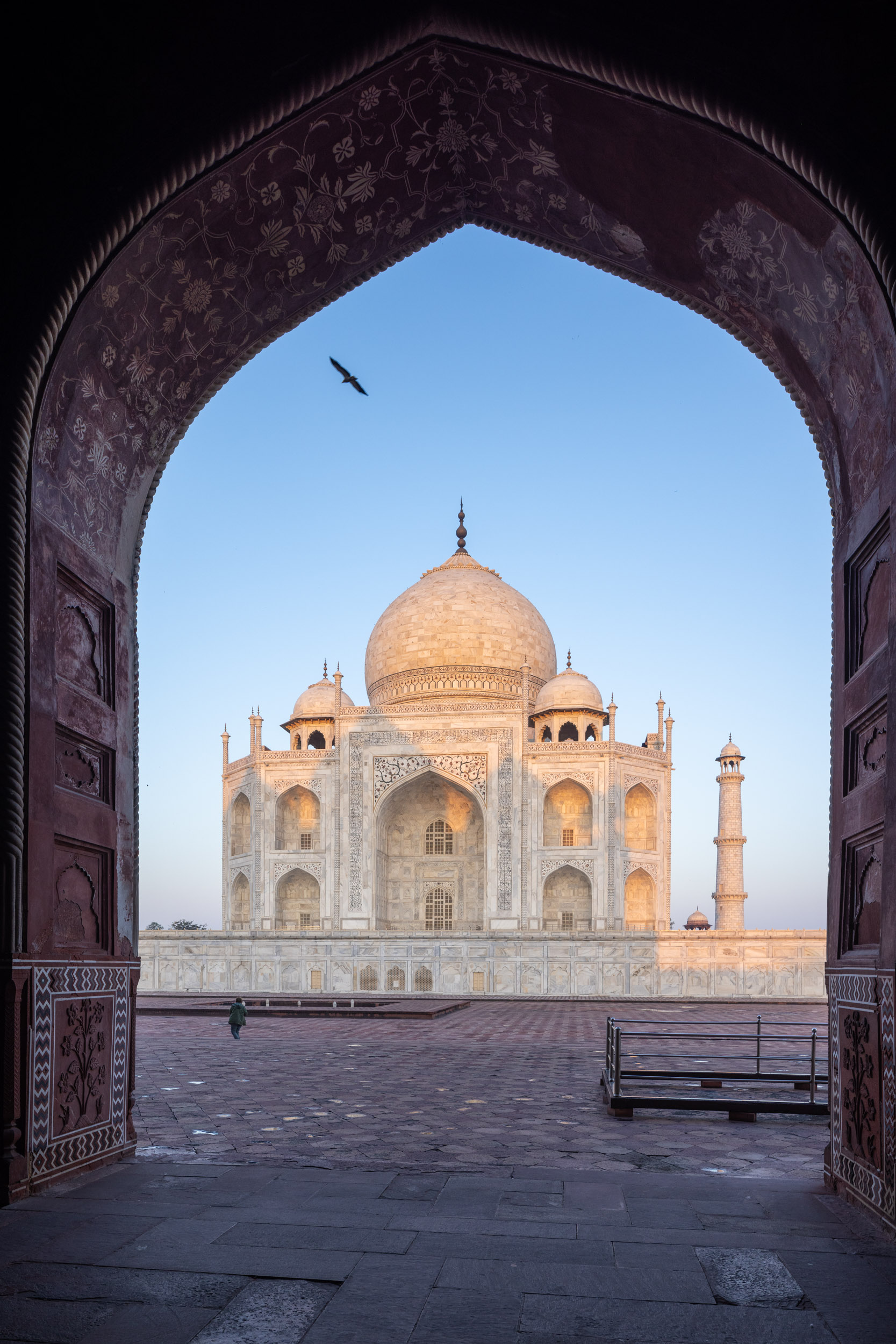
You’ll note above that I inform people that they should NOT take pictures of people without asking first in Upper Mustang, yet this was ignored. If Diamox has been prescribed, then it is to be taken at a certain point in the photography tour to avoid any issues to which was again ignored. And I was bluntly informed about the accommodation not being up to scratch. Well, again, it is all in the trip notes and on my website. Four-star hotels are just not available. The hospitality is four-star’s worth and more, but don’t expect to be waited on hand and foot. There is no heating in the hotels either, so you have to wrap up warm at night.
My friend and guide’s brother-in-law told me that last winter, he couldn’t have a wash for three months due to the cold up at Lo Manthang. Can you imagine that? Three months without one of those basic daily routines that most of us take for granted. Not even using cold water from the tap either as he said that by the time you get it on your face the water is near frozen and it would just be too damned cold to contemplate.
Upper Mustang is a magical area of Nepal. An area that was closed to outsiders until 1992. Small numbers of visitors go to the region every year due to the high cost of the permit that is required to enter. That high cost of $500 for 10 days is what sees that the area has a low number of visitors.
So please show respect to both the people and any tour leader who shows you around. It’s important.
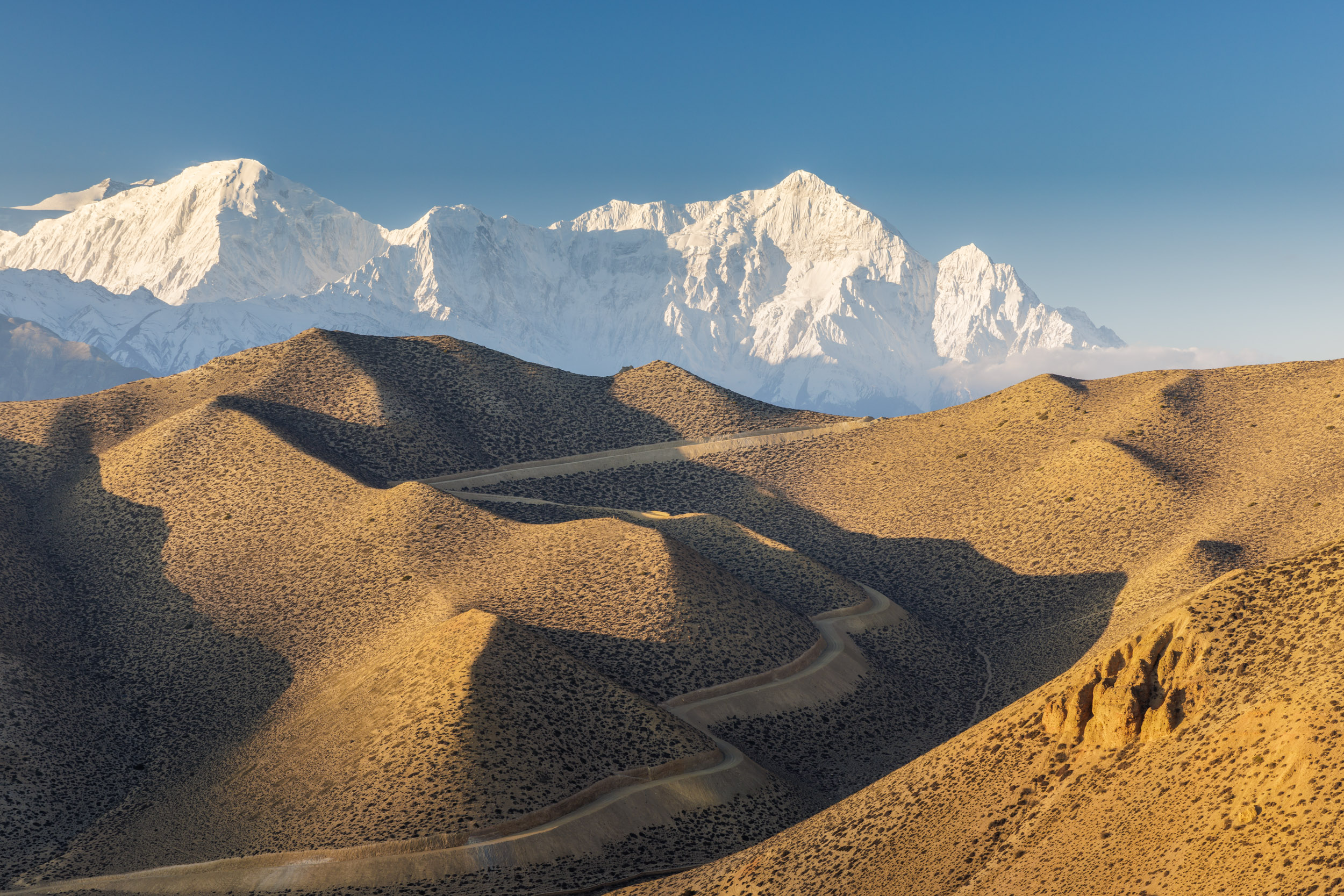
Tuscany. A landscape photographer’s paradise. A beautiful and magical area of central Italy that has become a huge draw to photographers of all ilk.
In May, I run a Tuscany photography tour due to the high possibility of getting fields of poppies. And the trip taking place this year didn’t disappoint.
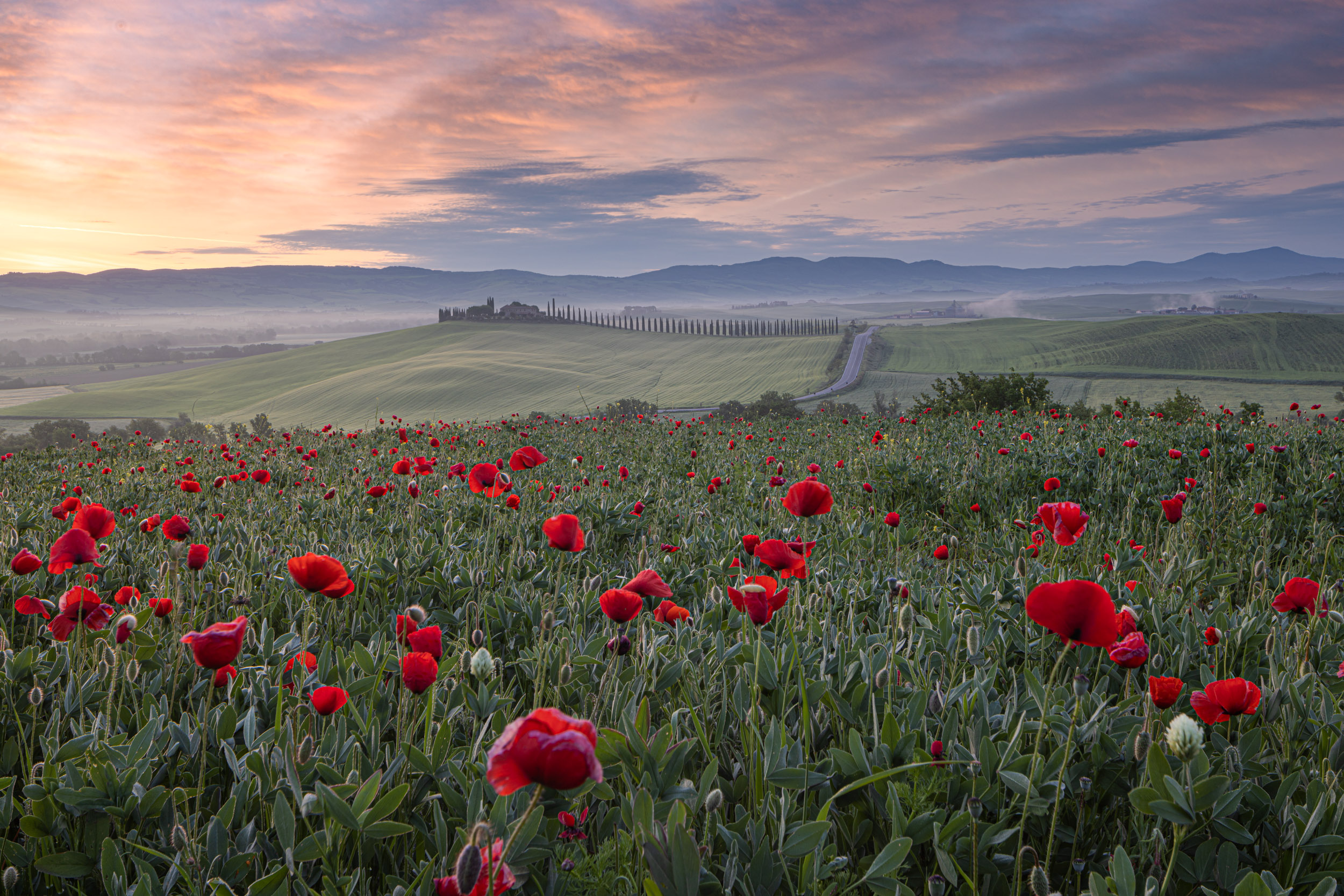
The Val d’Orcia, south of Siena, is where the majority of people will head to. This UNESCO-protected landscape is quite simply stunning at any time of the year, and it’s not hard to see why. Rolling hills and mist-filled valleys abound if conditions are right in the morning. And of course, if you go in May, then you have a decent chance of seeing the aforementioned poppies too, to add a huge splash of colour.
Now, in addition to the Val d’Orcia is another area called Crete Senesi. It’s bigger and just as beautiful as its more well-known cousin. It’s an area that I take people to, as well as it simply must be seen. You’re also more likely, in most instances, to leave behind the various tour groups than you find during May.

The weather during our week in the Tuscan landscape can be described as gloriously changeable. We were blessed with what I described at one point as being biblical light. The last couple of days saw a weather front pass over, and as such, the storm clouds and ever-changing light provided for truly memorable conditions, and I would go so far as to say that this was the best ever week I have spent here.
During May, the days are long and so you need to be up early. Really early! Actually, you may think it’s fine to arrive at a popular location such as the famous Belvedere farmhouse and expect to get your shot and move on, but you would be wrong.
It’s become one of those places where you have to arrive not just 15 minutes or so before sunrise but a good hour before sunrise in order to ensure that you’ll actually get a place! Photographers at this viewpoint are tripod to tripod, and you’ll often hear some grumbling as people set up.
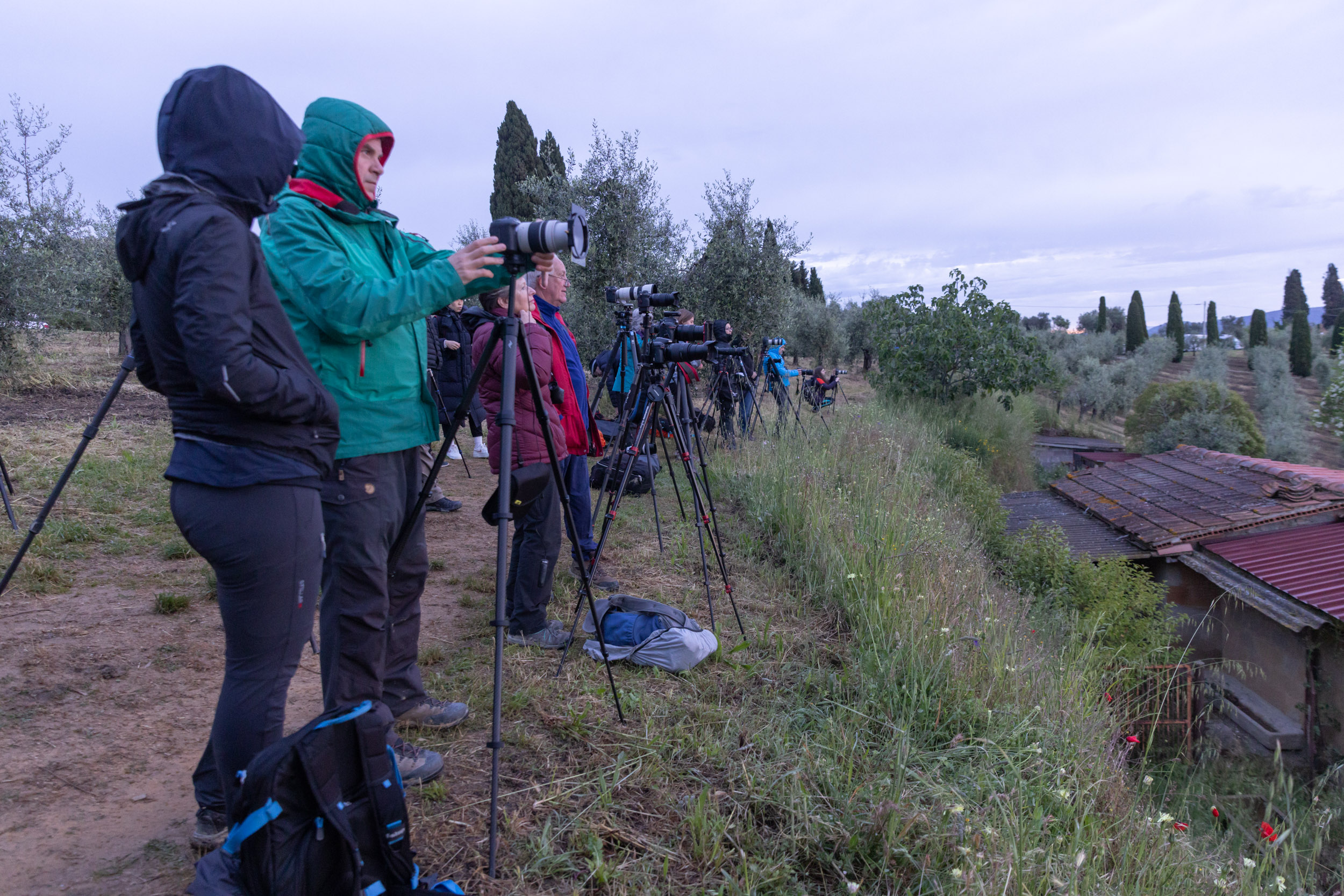
So is it worth going if it’s like this? Yes, because as mentioned before, there is the Crete Senesi, which provides other stunners and keeps you away from the madness. Research has to be done in order to ensure that clients are kept happy with stunning vistas. There are some well-known spots in the area, but there’s still much to be discovered.
What I found surprising, too, when the biblical light was going over the Val d’Orcia, was how empty it was of tour groups. I’m not sure how others operate, but I want people to have as many opportunities as possible to capture stunning scenes and leave fully satisfied, which is exactly what happened here.
So here are a couple of shots captured during that magical biblical light. Decide for yourself if it’s somewhere that you, too, want to see. Maybe I’m biased, but I think you need to see it at least once.
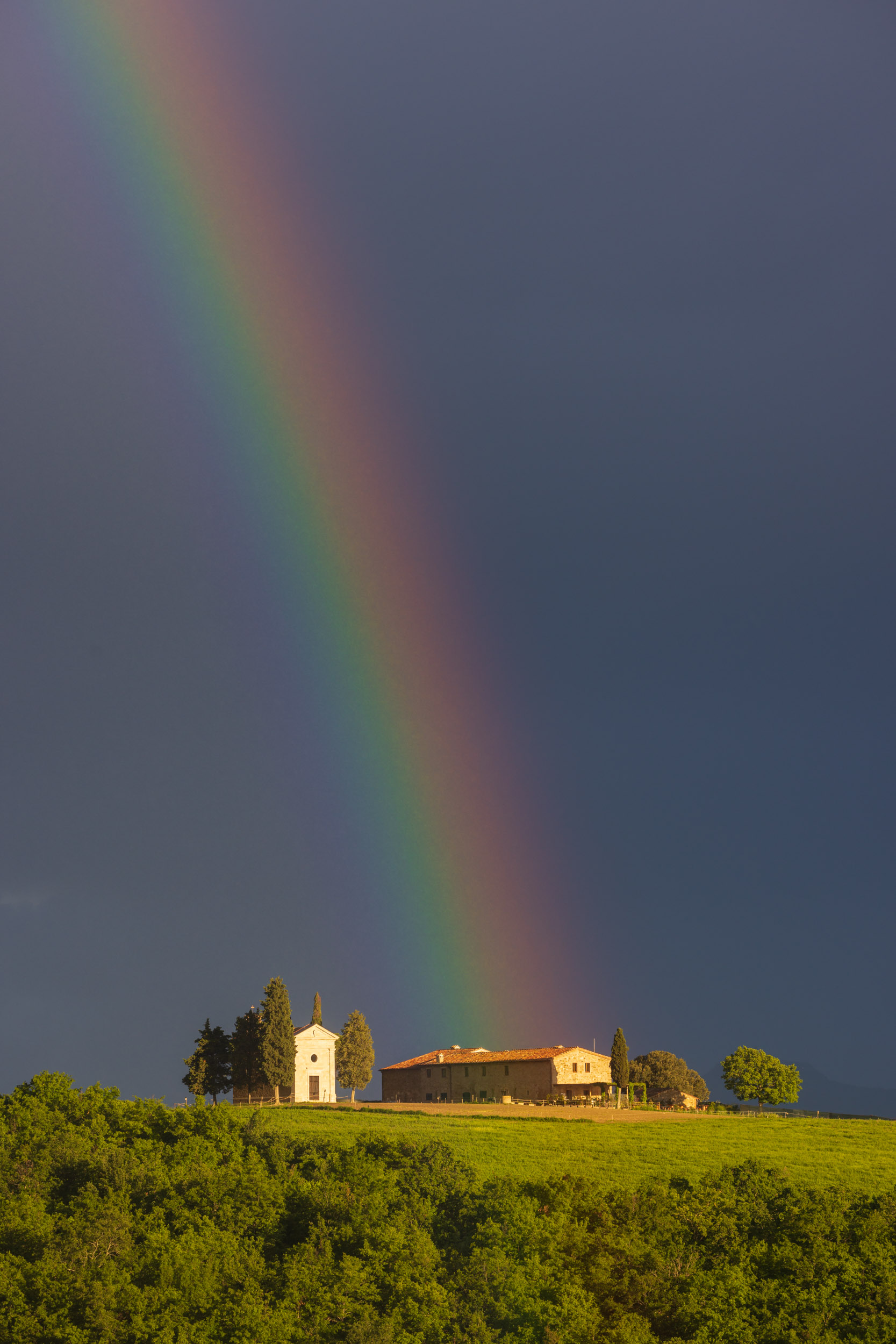
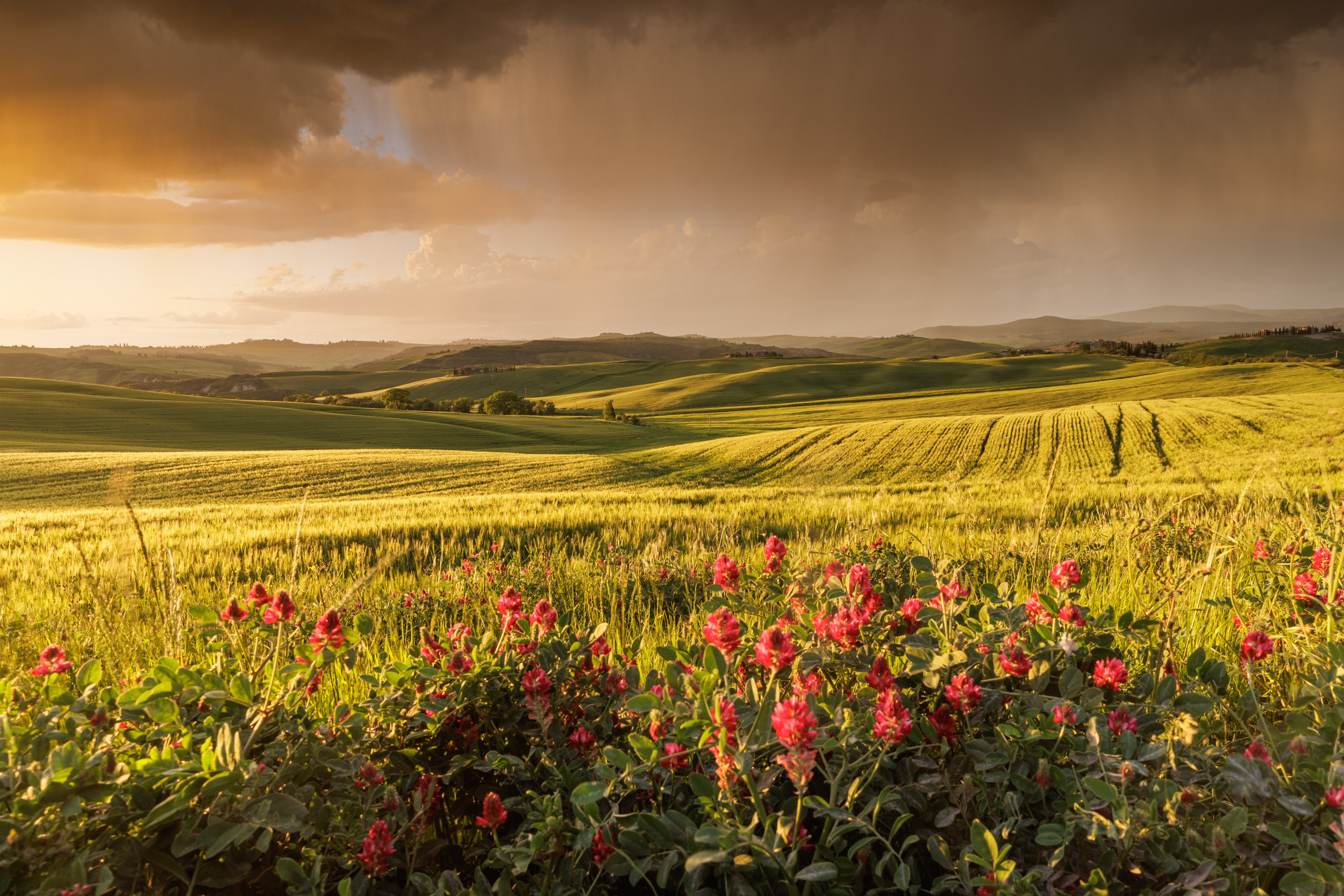
In early June I headed over to Vietnam again. As I said earlier on, it’s just too magical and so full of possibilities that I’m still scratching the surface.
The purpose of my visit was two-fold. To do some reconnaissance work for a June photography tour and also to spend nearly two weeks in Hanoi learning the language.
I’ve probably mentioned it before but it’s worth saying again. If you travel a lot then at least learn the common greetings in a language along with please and thank you as it goes a long way. So as I already knew a smattering of Vietnamese I set about filling in some gaps in the language as when I run my photography tours in Vietnam I want it to be a much more interesting time for people than just relying on the guide to do everything.
When you travel to Vietnam, or any other country for that matter, you’ll find that if you try to speak the local language, then you’ll get far more from people than you would normally do. You become much more interesting to local people as they are curious as to why you speak their language. And certainly with Vietnamese, given how difficult it can be, you are of definite interest, which is all good for a travel photographer who likes to engage with his subjects.
My Vietnamese lessons took place during the day, and so in the morning and evening, I was free to get some images of Hanoi. I was also doing a lot of filming during my nearly two weeks in the capital. Hopefully, the results of that will be on my YouTube channel when I get a moment to properly edit it.
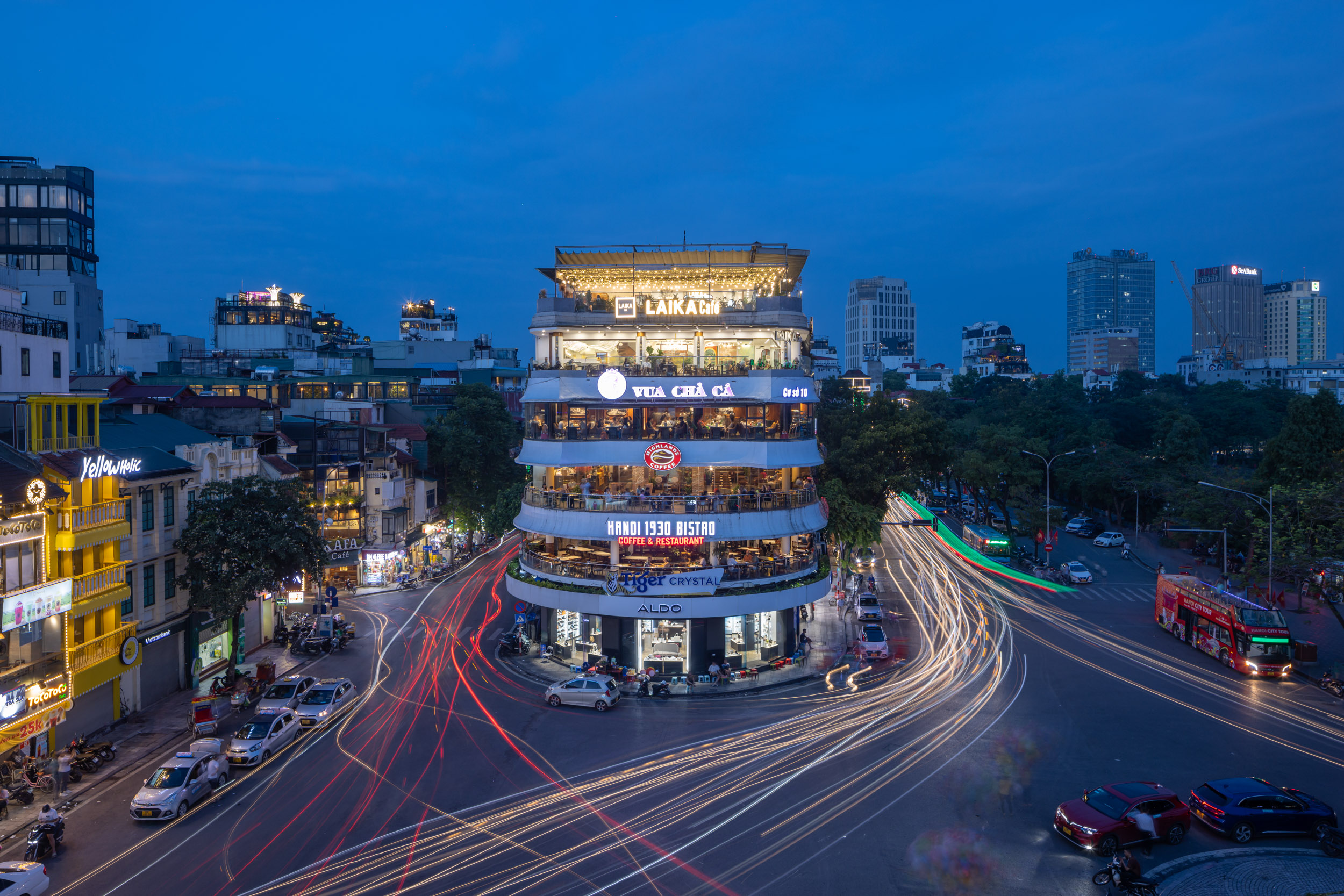
Then it was down to Hoi An again as there was some specific imagery that I was after.
Having never been to Vietnam in June time I had a list of things that I wanted to do. There were three absolute priorities for me, which were the lotus flowers, the traditional fishermen and also in the city of Hue, capturing a boatman with two ladies dressed in the traditional Ao Dai. Two out of three were done.
So the one that was missed was the lotus flowers. They just didn’t seem to be in bloom when I was there, which was frustrating, so it’ll have to wait until next year. However, let’s take a look at the two that I did capture.
First of all, the shots in Hue.
A friend of mine in Hanoi organises photography tours in Vietnam. I gave him a call and asked if he could help me set up the shot with the boatman and women in the traditional dress. Absolutely not a problem! So the wheels were set in motion and the nearly 3-hour drive was made up to Hue, ready to capture a scene I had seen a number of times.
The two young ladies were professional models, which helped a lot as they needed absolutely no direction at all, having done it a number of times for other photographers. This, in turn, makes my life and time easier as I’m not having to direct people whilst trying to capture the shots at hand.
The boat was prepared, and they, along with the boatman, headed out onto the river. All that was needed now was a colourful sunset, and the evening was set.
As you can see, the Gods smiled down, and the evening was nothing short of a huge success.
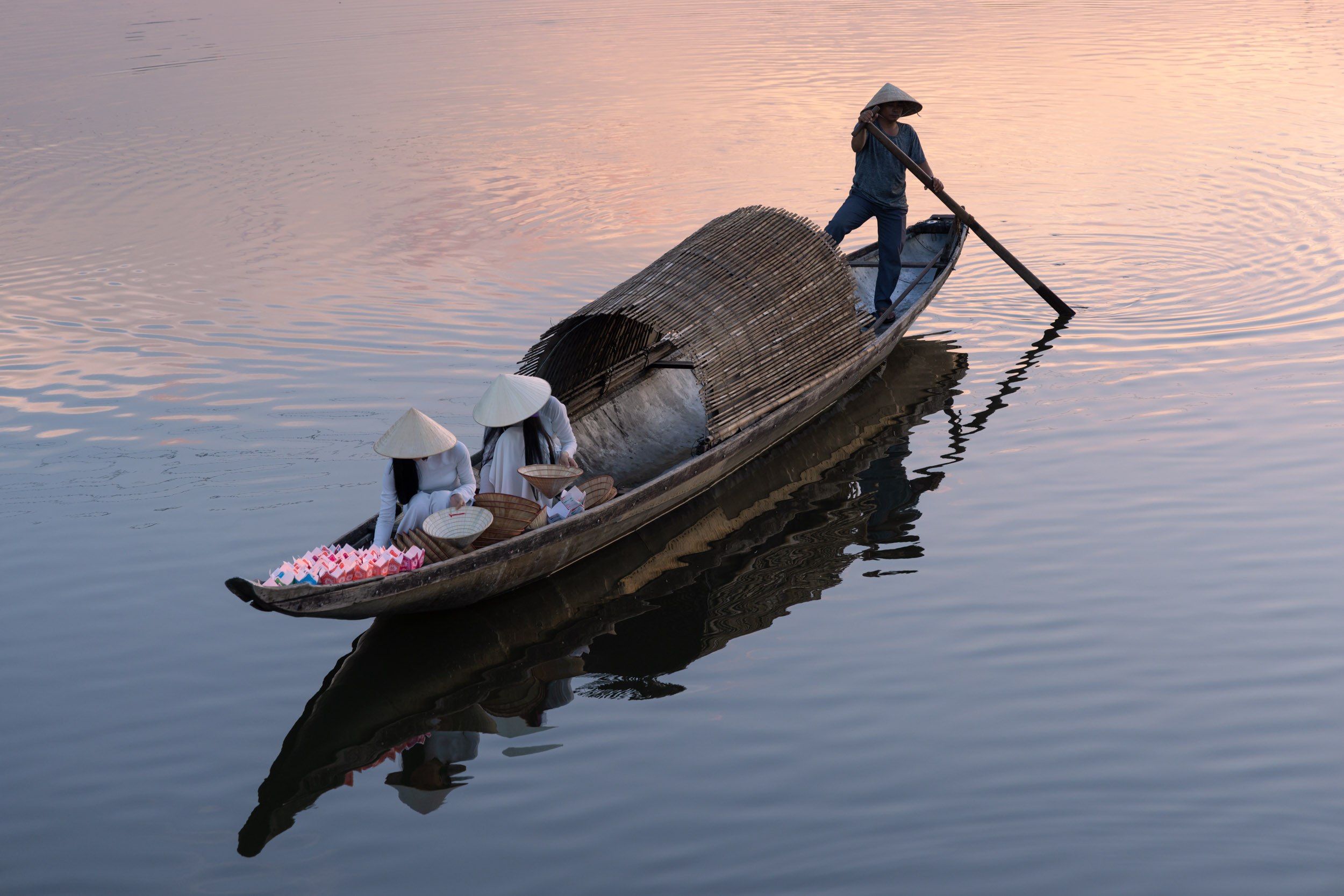
Secondly, the shots of the traditional fisherman in Quang Nam.
Another scene I’ve seen a lot of but never been around to properly capture is the traditional fishermen who work on the river in Quang Nam. The river is dotted with nets that are pulled up in the morning and evening to see the silvery fish that line the nets.
Again, I asked my friend in Hanoi if he could help me arrange things, and this in turn was done. It meant a very early start, but it was to prove an amazing end to the trip.
Arriving at the boat that goes out to the nets at 415am, you feel barely awake. The small tourist boat slowly puffs out, making its way down the river towards the nets. Arrangements have to be made with a fisherman so that they are there when we arrive.
Dropping anchor, you gaze over to the net being pulled up from the river before the fisherman goes over and starts what can only be described as a dance. He stands on the end of his small wooden boat with a stick, making sure the net gets out of the water. It is truly magical to watch as the sun rises and he becomes backlit by the morning light raking over the river at dawn.
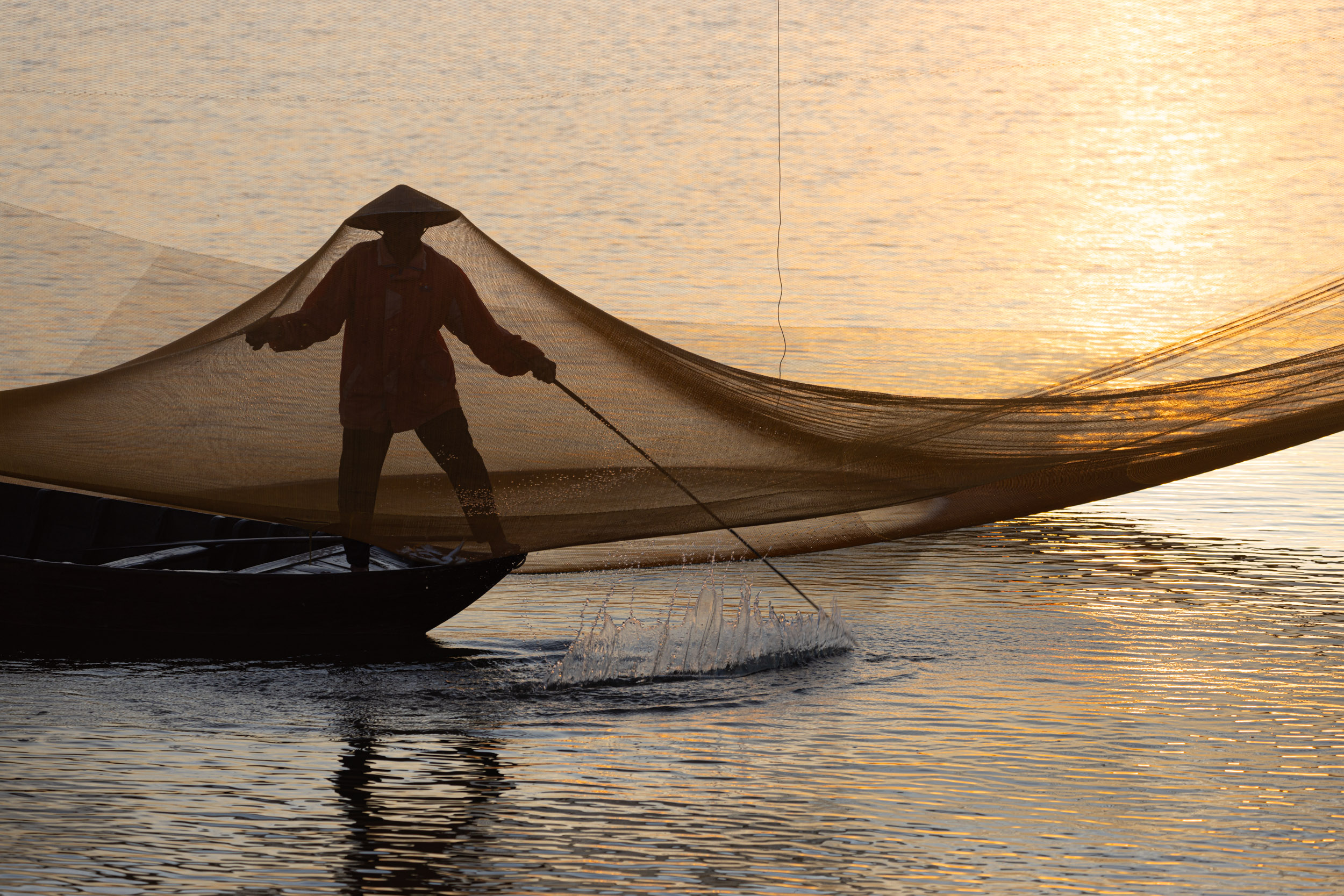
In addition to stills photography, I also flew my drone near the nets in order to get an altogether different angle on the fisherman. I personally don’t like flying over water, as you just never know, but thankfully, all was good and the resulting images were just mesmerising.
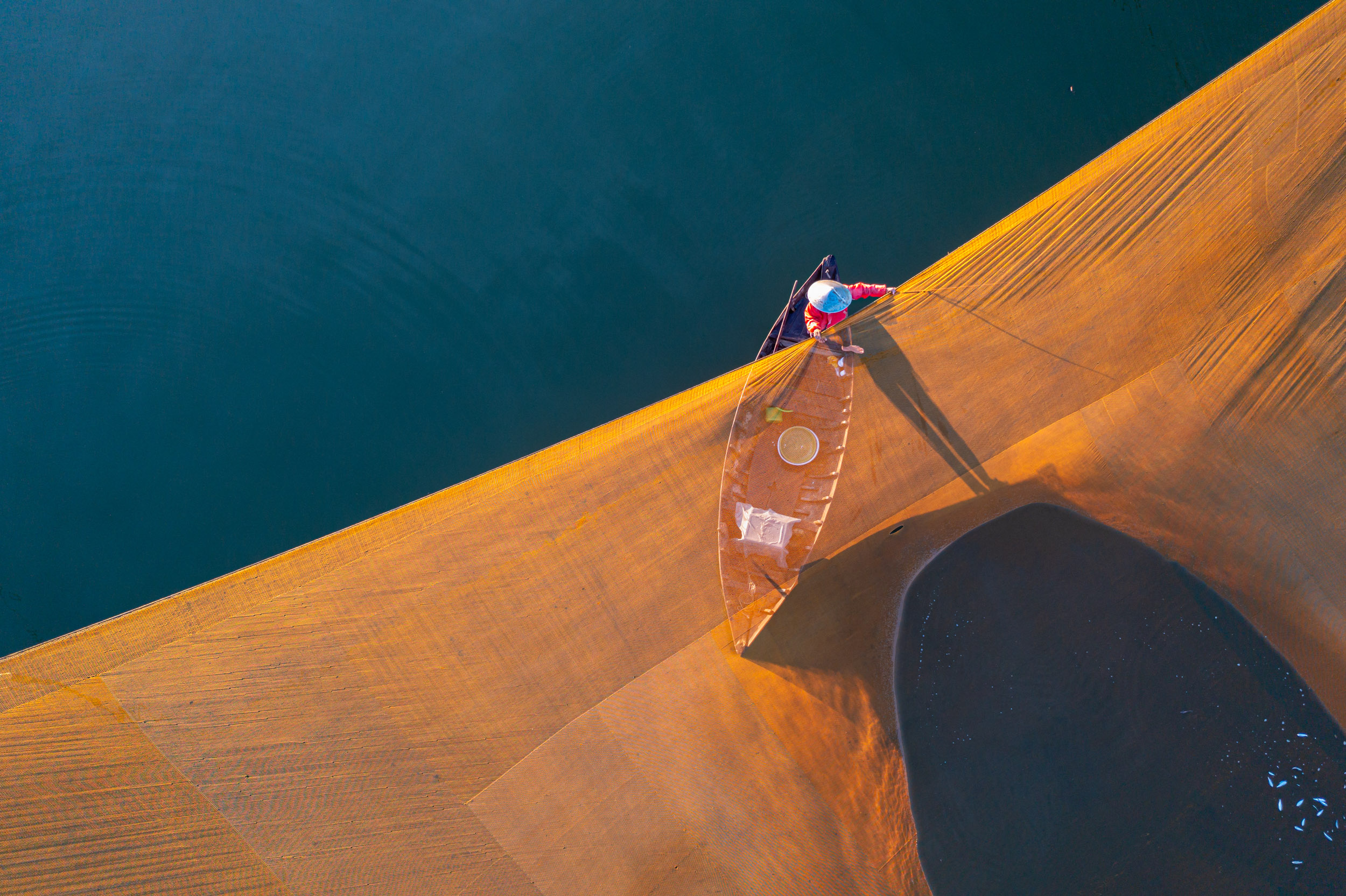
And if you’ve enjoyed reading the August 2023 newsletter and want to get it before it appears on my website, then feel free to sign up.
Don’t forget to use these links to “like” or “follow” my Facebook, YouTube and Instagram pages where I upload new images and vlogs. This is the best way to keep up to date with my latest work.